
hqq
Official implementation of Half-Quadratic Quantization (HQQ)
Stars: 879
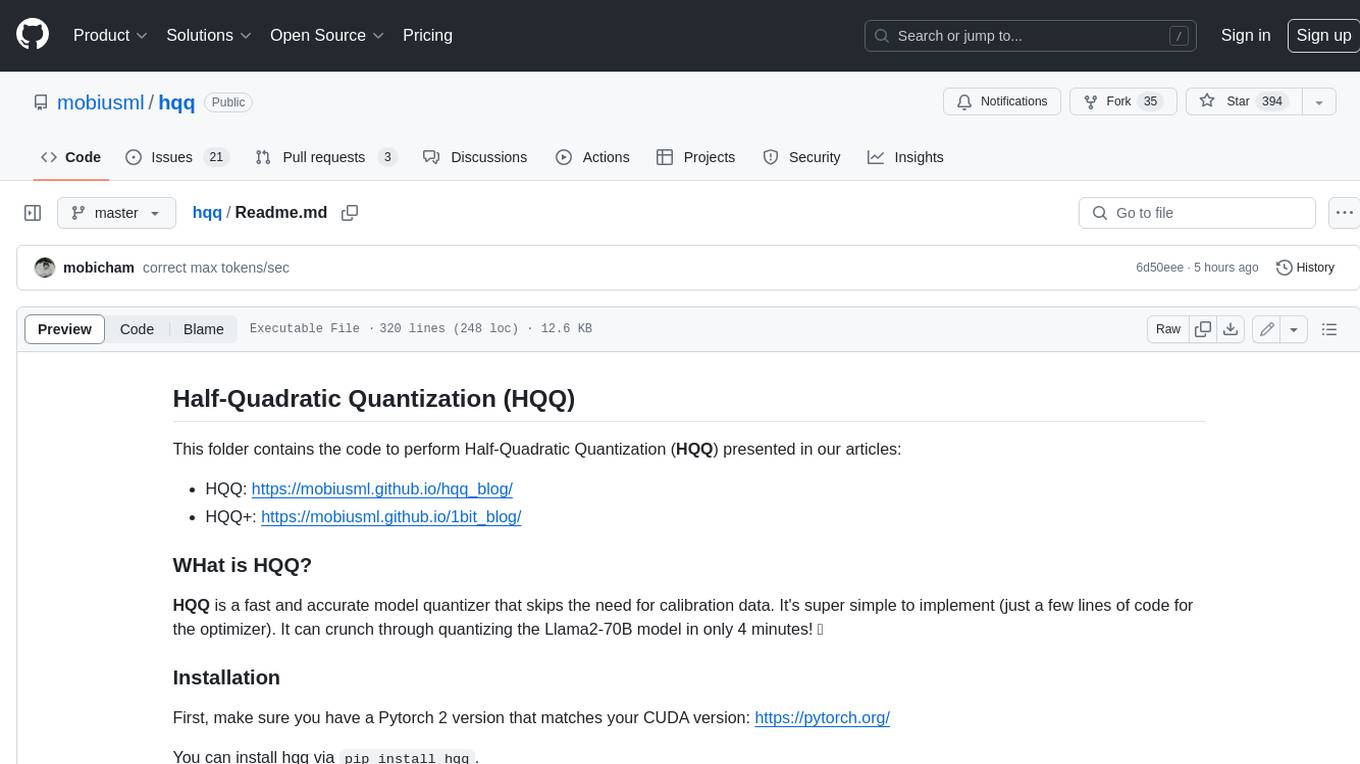
HQQ is a fast and accurate model quantizer that skips the need for calibration data. It's super simple to implement (just a few lines of code for the optimizer). It can crunch through quantizing the Llama2-70B model in only 4 minutes! 🚀
README:
This repository contains the official implementation of Half-Quadratic Quantization (HQQ) presented in our articles:
HQQ is a fast and accurate model quantizer that skips the need for calibration data. Quantize the largest models, without calibration data, in just a few minutes at most 🚀.
FAQ
Why should I use HQQ instead of other quantization methods?- HQQ is very fast to quantize models.
- It supports 8,4,3,2,1 bits.
- You can use it on any model (LLMs, Vision, etc.).
- The dequantization step is a linear operation, this means that HQQ is compatbile with various optimized CUDA/Triton kernels.
- HQQ is compatible with peft training.
- We try to make HQQ fully compatible `torch.compile` for faster inference and training.
What is the quality of the quantized models?
We have detailed benchmarks on both language and vision models. Please refer to our blog posts: HQQ, HQQ+.
What is the speed of the quantized models?
4-bit models with axis=1 can use optimized inference fused kernels. Moreover, we focus on making hqq fully compatible with torch.compile which speeds-up both training and inference. For more details, please refer to the backend section below.
What quantization settings should I use?
You should start with nbits=4, group_size=64, axis=1. These settings offer a good balance between quality, vram usage and speed. If you want better results with the same vram usage, switch to axis=0 and use the ATEN backend, but this setting is not supported for fast inference.
What does the axis parameter mean?
The axis parameter is the axis along which grouping is performed. In general axis=0 gives better results than axis=1, especially at lower bits. However, the optimized inference runtime only supports axis=1 for the moment.
What is the difference between HQQ and HQQ+?
HQQ+ is HQQ with trainable low-rank adapters to improve the quantization quality at lower bits.
First, make sure you have a Pytorch 2 version that matches your CUDA version: https://pytorch.org/
You can install hqq via
#latest stable version
pip install hqq;
#Latest updates - recommended
pip install git+https://github.com/mobiusml/hqq.git;
#Disable building the CUDA kernels for the aten backend
DISABLE_CUDA=1 pip install ...
Alternatively, clone the repo and run pip install . from this current folder.
To perform quantization with HQQ, you simply need to replace the linear layers ( torch.nn.Linear) as follows:
from hqq.core.quantize import *
#Quantization settings
quant_config = BaseQuantizeConfig(nbits=4, group_size=64)
#Replace your linear layer
hqq_layer = HQQLinear(your_linear_layer, #torch.nn.Linear or None
quant_config=quant_config, #quantization configuration
compute_dtype=torch.float16, #compute dtype
device='cuda', #cuda device
initialize=True, #Use False to quantize later
del_orig=True #if True, delete the original layer
)
W_r = hqq_layer.dequantize() #dequantize()
W_q = hqq_layer.unpack(dtype=torch.uint8) #unpack
y = hqq_layer(x) #forward-passThe quantization parameters are set as follows:
-
nbits(int): supports 8, 4, 3, 2, 1 bits. -
group_size(int): no restrictions as long asweight.numel()is divisible by thegroup_size. -
view_as_float(bool): if True, the quantized parameter is viewed as float instead of an int type.
For usage with HF's transformers, see the example below from the documentation:
from transformers import AutoModelForCausalLM, HqqConfig
# All linear layers will use the same quantization config
quant_config = HqqConfig(nbits=4, group_size=64)
# Load and quantize
model = AutoModelForCausalLM.from_pretrained(
model_id,
torch_dtype=torch.float16,
device_map="cuda",
quantization_config=quant_config
)You can save/load quantized models as regular transformers models via save_pretrained / from_pretrained.
You can also utilize the HQQ library to quantize transformers models:
#Load the model on CPU
from transformers import AutoModelForCausalLM
model = AutoModelForCausalLM.from_pretrained(model_id, torch_dtype=compute_dtype)
#Quantize
from hqq.models.hf.base import AutoHQQHFModel
quant_config = BaseQuantizeConfig(nbits=4, group_size=64)
AutoHQQHFModel.quantize_model(model, quant_config=quant_config, compute_dtype=compute_dtype, device=device)You can save/load quantized models as follows:
from hqq.models.hf.base import AutoHQQHFModel
#Save: Make sure to save the model BEFORE any patching
AutoHQQHFModel.save_quantized(model, save_dir)
#Save as safetensors (to be load via transformers or vllm)
AutoHQQHFModel.save_to_safetensors(model, save_dir)
#Load
model = AutoHQQHFModel.from_quantized(save_dir)❗ Note that models saved via the hqq lib are not compatible with .from_pretrained()
The following native dequantization backends can be used by the HQQLinear module:
HQQLinear.set_backend(HQQBackend.PYTORCH) #Pytorch backend - Default
HQQLinear.set_backend(HQQBackend.PYTORCH_COMPILE) #Compiled Pytorch
HQQLinear.set_backend(HQQBackend.ATEN) #Aten/CUDA backend - only axis=0 supported❗ Note that HQQBackend.ATEN only supports axis=0.
We support external backends for faster inference with fused kernels. You can enable one of the backends after the model was quantized as follows:
from hqq.utils.patching import prepare_for_inference
#Pytorch backend that makes the model compatible with fullgraph torch.compile: works with any settings
#prepare_for_inference(model)
#Gemlite backend: nbits=4/2/1, compute_dtype=float16, axis=1
prepare_for_inference(model, backend="gemlite")
#Torchao's tiny_gemm backend (fast for batch-size<4): nbits=4, compute_dtype=bfloat16, axis=1
#prepare_for_inference(model, backend="torchao_int4") Note that these backends only work with axis=1. Additional restrictions apply regarding the group-size values depending on the backend. You should expect ~158 tokens/sec with a Llama3-8B 4-bit quantized model on a 4090 RTX.
When a quantization config is not supported by the specified inference backend, hqq will fallback to the native backend.
You can set up various quantization configurations for different layers by specifying the settings for each layer name:
# Each linear layer with the same tag will use a dedicated quantization config
q4_config = {'nbits':4, 'group_size':64}
q3_config = {'nbits':3, 'group_size':32}
quant_config = HqqConfig(dynamic_config={
'self_attn.q_proj':q4_config,
'self_attn.k_proj':q4_config,
'self_attn.v_proj':q4_config,
'self_attn.o_proj':q4_config,
'mlp.gate_proj':q3_config,
'mlp.up_proj' :q3_config,
'mlp.down_proj':q3_config,
})from hqq.core.quantize import *
q4_config = BaseQuantizeConfig(nbits=4, group_size=64)
q3_config = BaseQuantizeConfig(nbits=3, group_size=32)
quant_config = {'self_attn.q_proj':q4_config,
'self_attn.k_proj':q4_config,
'self_attn.v_proj':q4_config,
'self_attn.o_proj':q4_config,
'mlp.gate_proj':q3_config,
'mlp.up_proj' :q3_config,
'mlp.down_proj':q3_config,
}You can use HQQ in vllm. Make sure to install GemLite before using the backend.
#Or you can quantize on-the-fly
from hqq.utils.vllm import set_vllm_onthefly_hqq_quant
skip_modules = ['lm_head', 'visual', 'vision']
#Select one of the following modes:
#INT/FP format
set_vllm_onthefly_hqq_quant(weight_bits=8, group_size=None, quant_mode='int8_weightonly', skip_modules=skip_modules) #A16W8 - INT8 weight only
set_vllm_onthefly_hqq_quant(weight_bits=4, group_size=128, quant_mode='int4_weightonly', skip_modules=skip_modules) #A16W4 - HQQ weight only
set_vllm_onthefly_hqq_quant(weight_bits=8, quant_mode='int8_dynamic', skip_modules=skip_modules) #A8W8 - INT8 x INT8 dynamic
set_vllm_onthefly_hqq_quant(weight_bits=8, quant_mode='fp8_dynamic', skip_modules=skip_modules) #A8W8 - FP8 x FP8 dynamic
#MXFP format
set_vllm_onthefly_hqq_quant(weight_bits=8, group_size=None, quant_mode='mxfp8_dynamic', skip_modules=skip_modules) #A8W8 - MXFP8 x MXPF8 - post_scale=True
set_vllm_onthefly_hqq_quant(weight_bits=8, group_size=32, quant_mode='mxfp8_dynamic', skip_modules=skip_modules) #A8W8 - MXFP8 x MXPF8- post_scale=False
set_vllm_onthefly_hqq_quant(weight_bits=4, quant_mode='mxfp4_weightonly', skip_modules=skip_modules) #A16W4 - MXFP4 weight-only
set_vllm_onthefly_hqq_quant(weight_bits=4, quant_mode='mxfp8_dynamic', skip_modules=skip_modules) #A8W4 - MXFP8 x MXFP4 dynamic
set_vllm_onthefly_hqq_quant(weight_bits=4, quant_mode='mxfp4_dynamic', skip_modules=skip_modules) #A4W4 - MXPF4 x MXPF4 dynamic
set_vllm_onthefly_hqq_quant(weight_bits=4, quant_mode='nvfp4_dynamic', skip_modules=skip_modules) #A4W4 - NVFP4 x NVFP4 dynamic
llm = LLM(model="meta-llama/Llama-3.2-3B-Instruct", max_model_len=4096, gpu_memory_utilization=0.80, dtype=torch.float16)Peft training is directly supported in the HuggingFace's peft library. If you still want to use hqq-lib's peft utilities, here's how:
#First, quantize/load a quantized HQQ model the
from hqq.core.peft import PeftUtils
base_lora_params = {'lora_type':'default', 'r':32, 'lora_alpha':64, 'dropout':0.05, 'train_dtype':torch.float32}
lora_params = {'self_attn.q_proj': base_lora_params,
'self_attn.k_proj': base_lora_params,
'self_attn.v_proj': base_lora_params,
'self_attn.o_proj': base_lora_params,
'mlp.gate_proj' : None,
'mlp.up_proj' : None,
'mlp.down_proj' : None}
#Add LoRA to linear/HQQ modules
PeftUtils.add_lora(model, lora_params)
#Optional: set your backend
HQQLinear.set_backend(HQQBackend.ATEN if axis==0 else HQQBackend.PYTORCH_COMPILE)
#Train ....
#Convert LoRA weights to the same model dtype for faster inference
model.eval()
PeftUtils.cast_lora_weights(model, dtype=compute_dtype)
#Save LoRA weights
PeftUtils.save_lora_weights(model, filename)
#Load LoRA weights: automatically calls add_lora
PeftUtils.load_lora_weights(model, filename)We provide a complete example to train a model with HQQ/LoRA that you can find in examples/hqq_plus.py.
If you want to use muti-gpu training via FSDP, check out this awesome repo by Answer.AI: https://github.com/AnswerDotAI/fsdp_qlora
We provide a variety of examples demonstrating model quantization across different backends within the examples directory.
@misc{badri2023hqq,
title = {Half-Quadratic Quantization of Large Machine Learning Models},
url = {https://mobiusml.github.io/hqq_blog/},
author = {Hicham Badri and Appu Shaji},
month = {November},
year = {2023}
For Tasks:
Click tags to check more tools for each tasksFor Jobs:
Alternative AI tools for hqq
Similar Open Source Tools

hqq
HQQ is a fast and accurate model quantizer that skips the need for calibration data. It's super simple to implement (just a few lines of code for the optimizer). It can crunch through quantizing the Llama2-70B model in only 4 minutes! 🚀
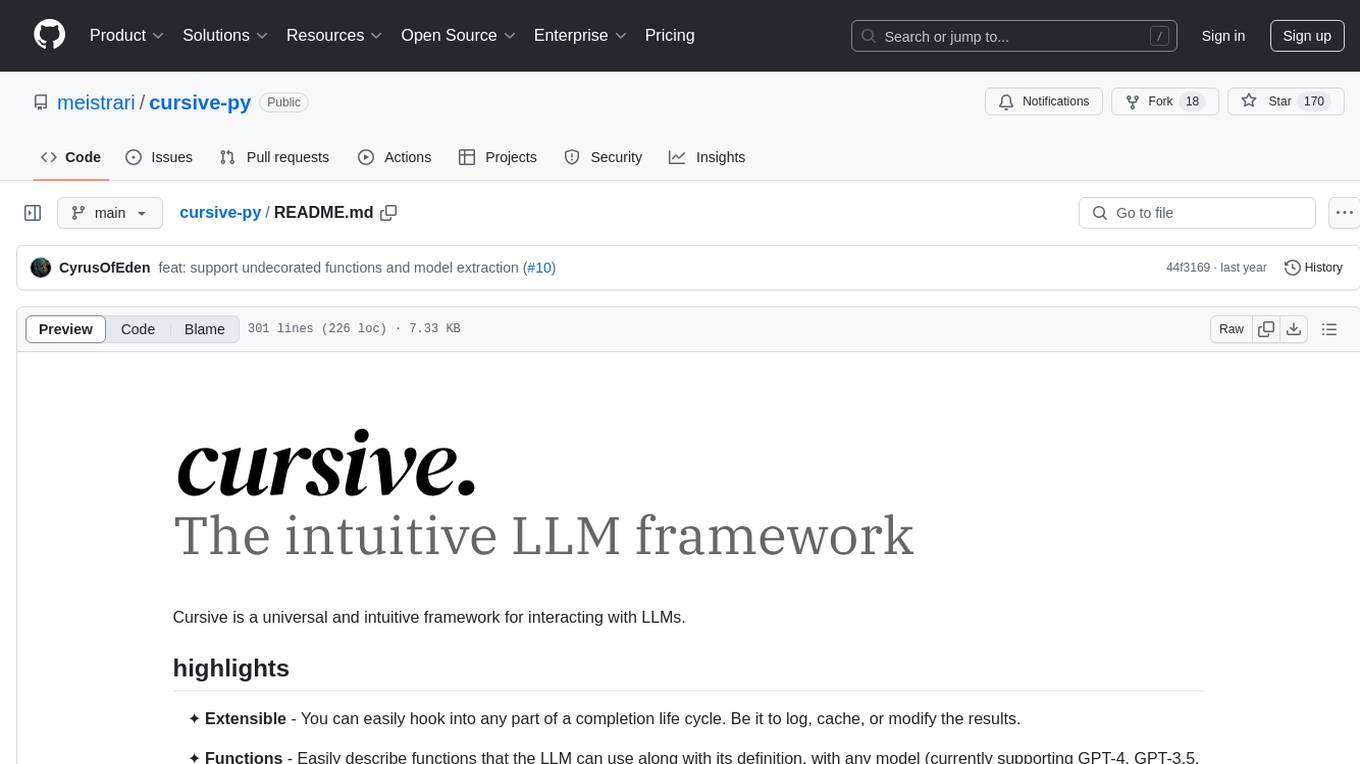
cursive-py
Cursive is a universal and intuitive framework for interacting with LLMs. It is extensible, allowing users to hook into any part of a completion life cycle. Users can easily describe functions that LLMs can use with any supported model. Cursive aims to bridge capabilities between different models, providing a single interface for users to choose any model. It comes with built-in token usage and costs calculations, automatic retry, and model expanding features. Users can define and describe functions, generate Pydantic BaseModels, hook into completion life cycle, create embeddings, and configure retry and model expanding behavior. Cursive supports various models from OpenAI, Anthropic, OpenRouter, Cohere, and Replicate, with options to pass API keys for authentication.
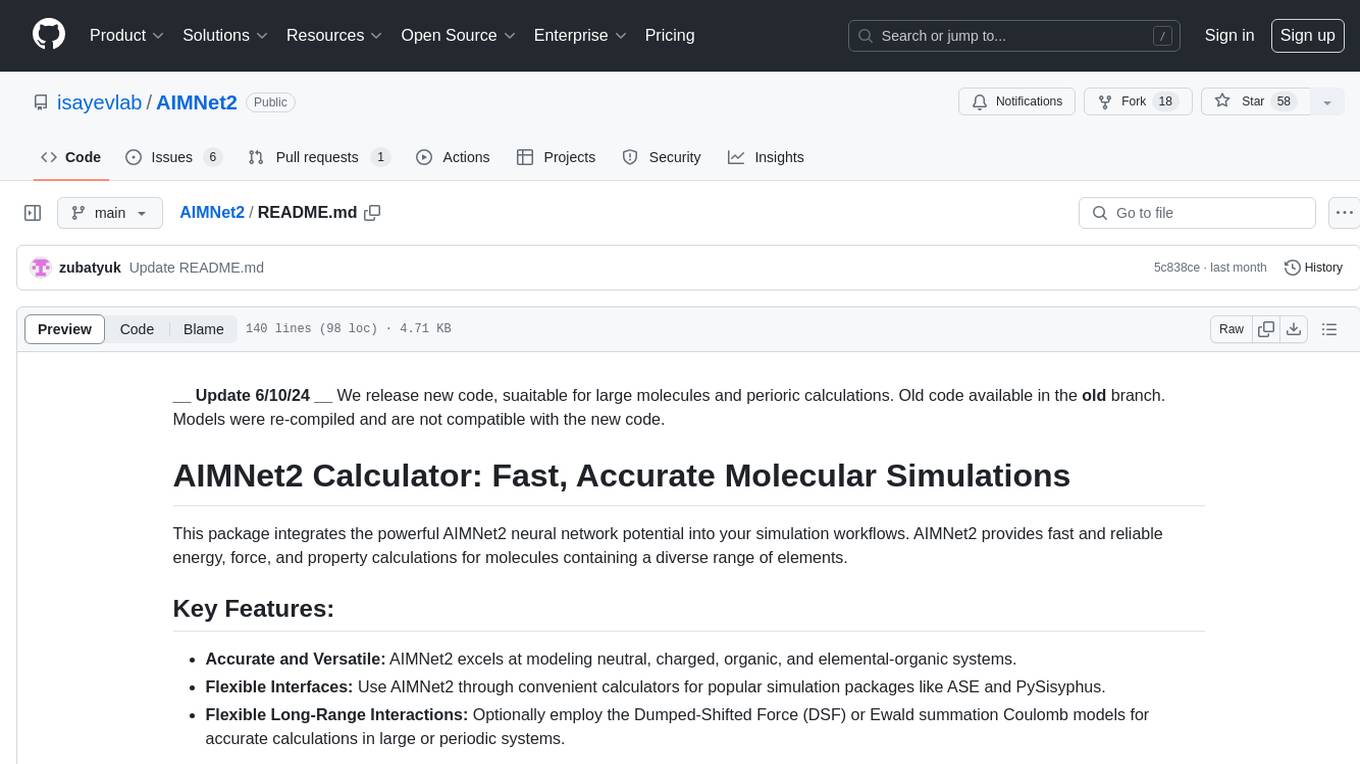
AIMNet2
AIMNet2 Calculator is a package that integrates the AIMNet2 neural network potential into simulation workflows, providing fast and reliable energy, force, and property calculations for molecules with diverse elements. It excels at modeling various systems, offers flexible interfaces for popular simulation packages, and supports long-range interactions using DSF or Ewald summation Coulomb models. The tool is designed for accurate and versatile molecular simulations, suitable for large molecules and periodic calculations.
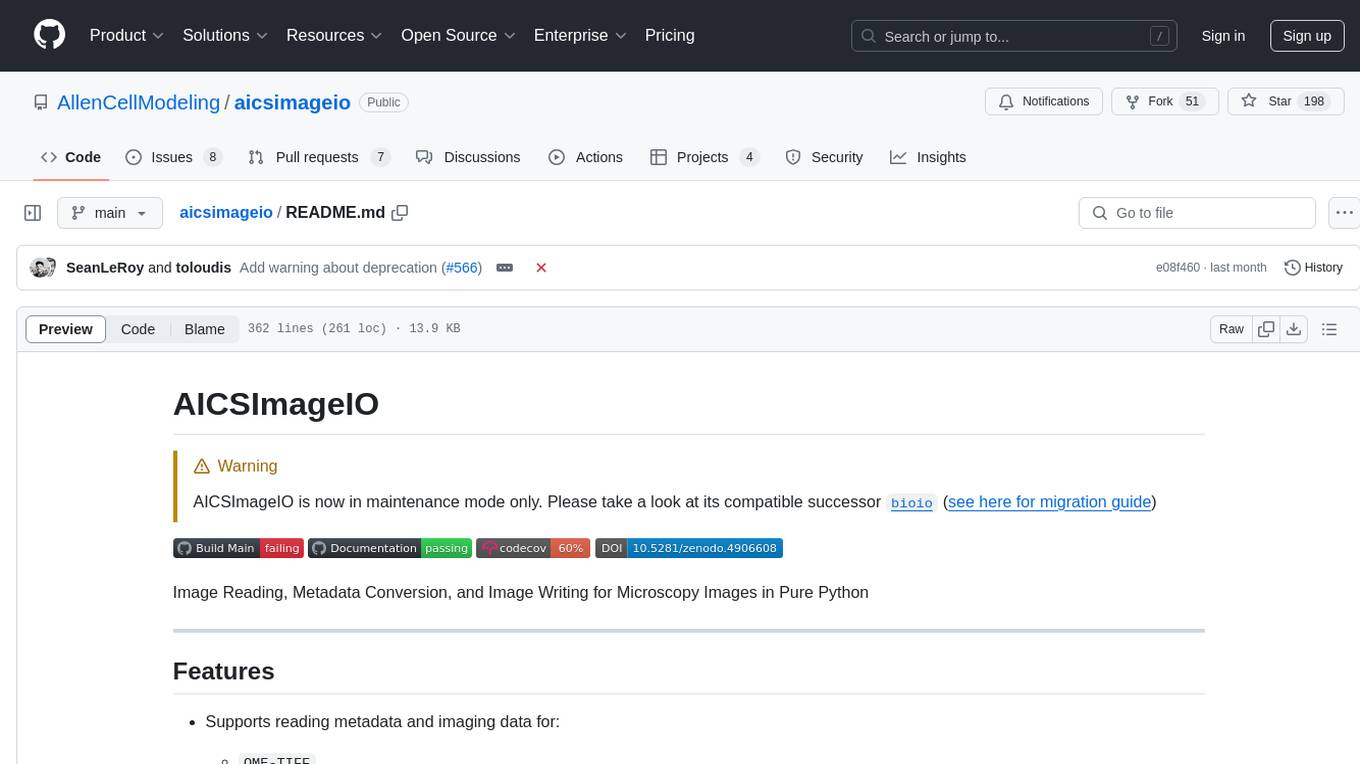
aicsimageio
AICSImageIO is a Python tool for Image Reading, Metadata Conversion, and Image Writing for Microscopy Images. It supports various file formats like OME-TIFF, TIFF, ND2, DV, CZI, LIF, PNG, GIF, and Bio-Formats. Users can read and write metadata and imaging data, work with different file systems like local paths, HTTP URLs, s3fs, and gcsfs. The tool provides functionalities for full image reading, delayed image reading, mosaic image reading, metadata reading, xarray coordinate plane attachment, cloud IO support, and saving to OME-TIFF. It also offers benchmarking and developer resources.
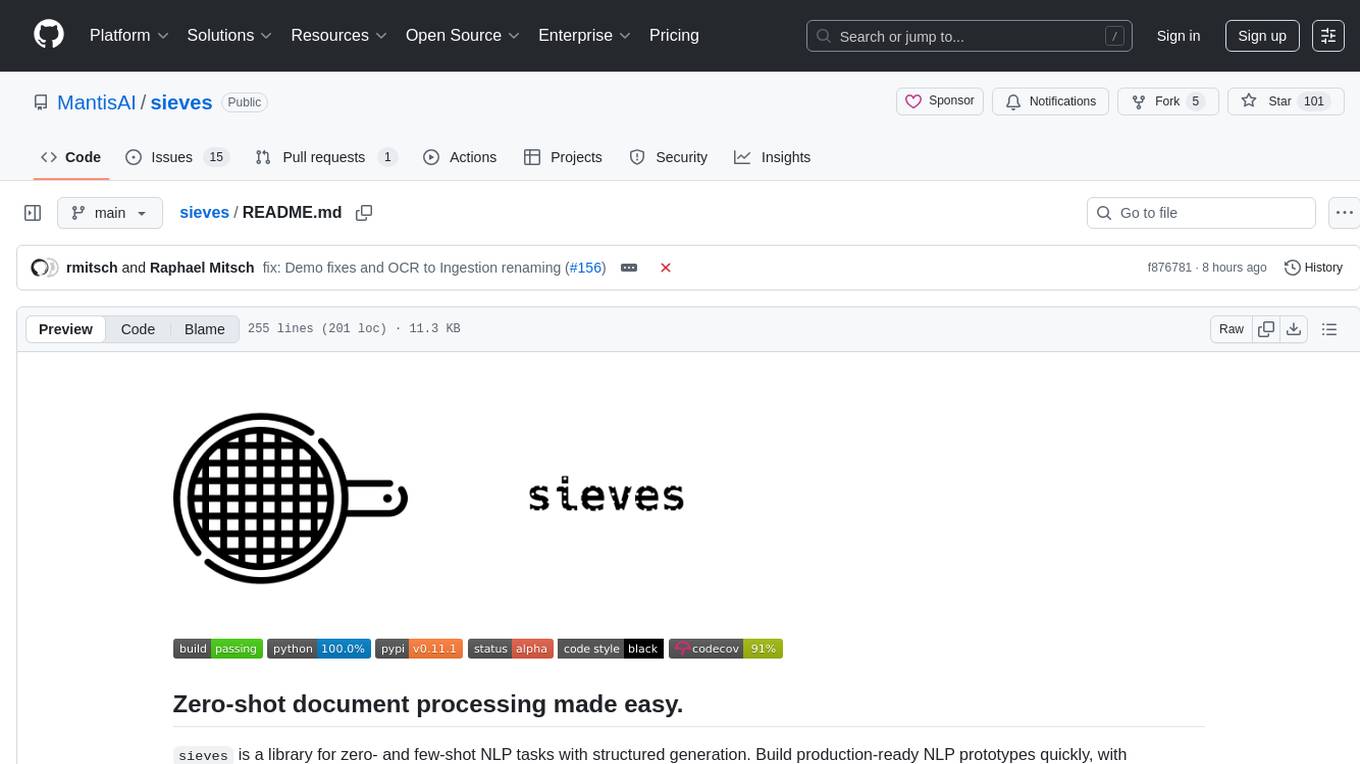
sieves
sieves is a library for zero- and few-shot NLP tasks with structured generation, enabling rapid prototyping of NLP applications without the need for training. It simplifies NLP prototyping by bundling capabilities into a single library, providing zero- and few-shot model support, a unified interface for structured generation, built-in tasks for common NLP operations, easy extendability, document-based pipeline architecture, caching to prevent redundant model calls, and more. The tool draws inspiration from spaCy and spacy-llm, offering features like immediate inference, observable pipelines, integrated tools for document parsing and text chunking, ready-to-use tasks such as classification, summarization, translation, and more, persistence for saving and loading pipelines, distillation for specialized model creation, and caching to optimize performance.
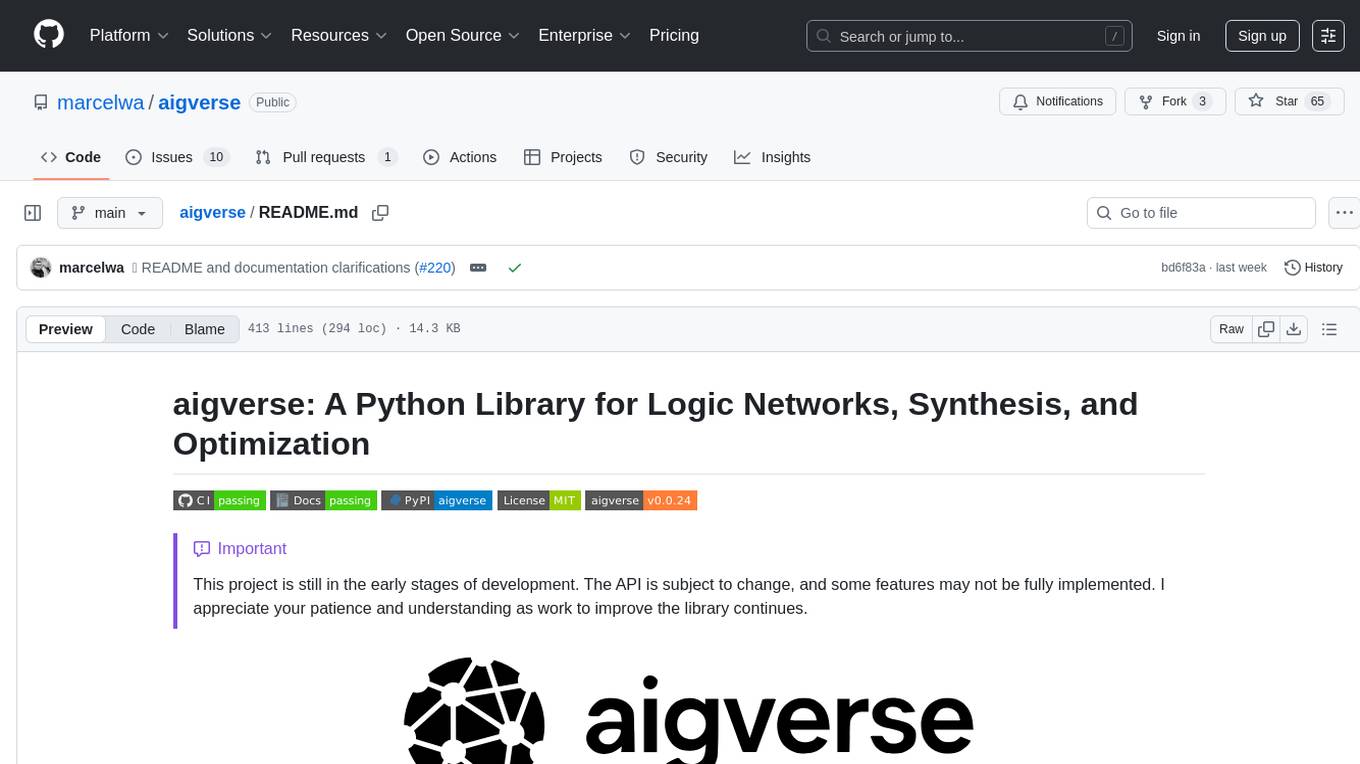
aigverse
aigverse is a Python infrastructure framework that bridges the gap between logic synthesis and AI/ML applications. It allows efficient representation and manipulation of logic circuits, making it easier to integrate logic synthesis and optimization tasks into machine learning pipelines. Built upon EPFL Logic Synthesis Libraries, particularly mockturtle, aigverse provides a high-level Python interface to state-of-the-art algorithms for And-Inverter Graph (AIG) manipulation and logic synthesis, widely used in formal verification, hardware design, and optimization tasks.
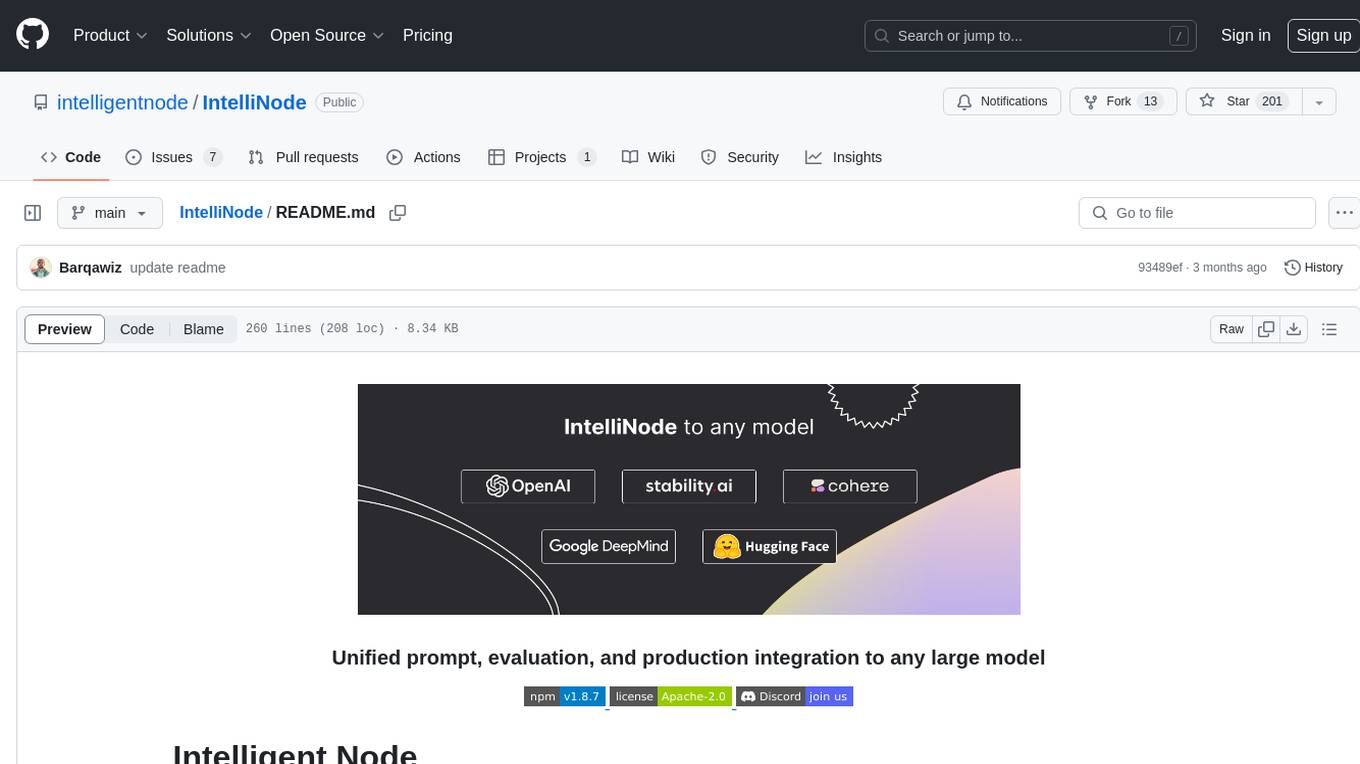
IntelliNode
IntelliNode is a javascript module that integrates cutting-edge AI models like ChatGPT, LLaMA, WaveNet, Gemini, and Stable diffusion into projects. It offers functions for generating text, speech, and images, as well as semantic search, multi-model evaluation, and chatbot capabilities. The module provides a wrapper layer for low-level model access, a controller layer for unified input handling, and a function layer for abstract functionality tailored to various use cases.
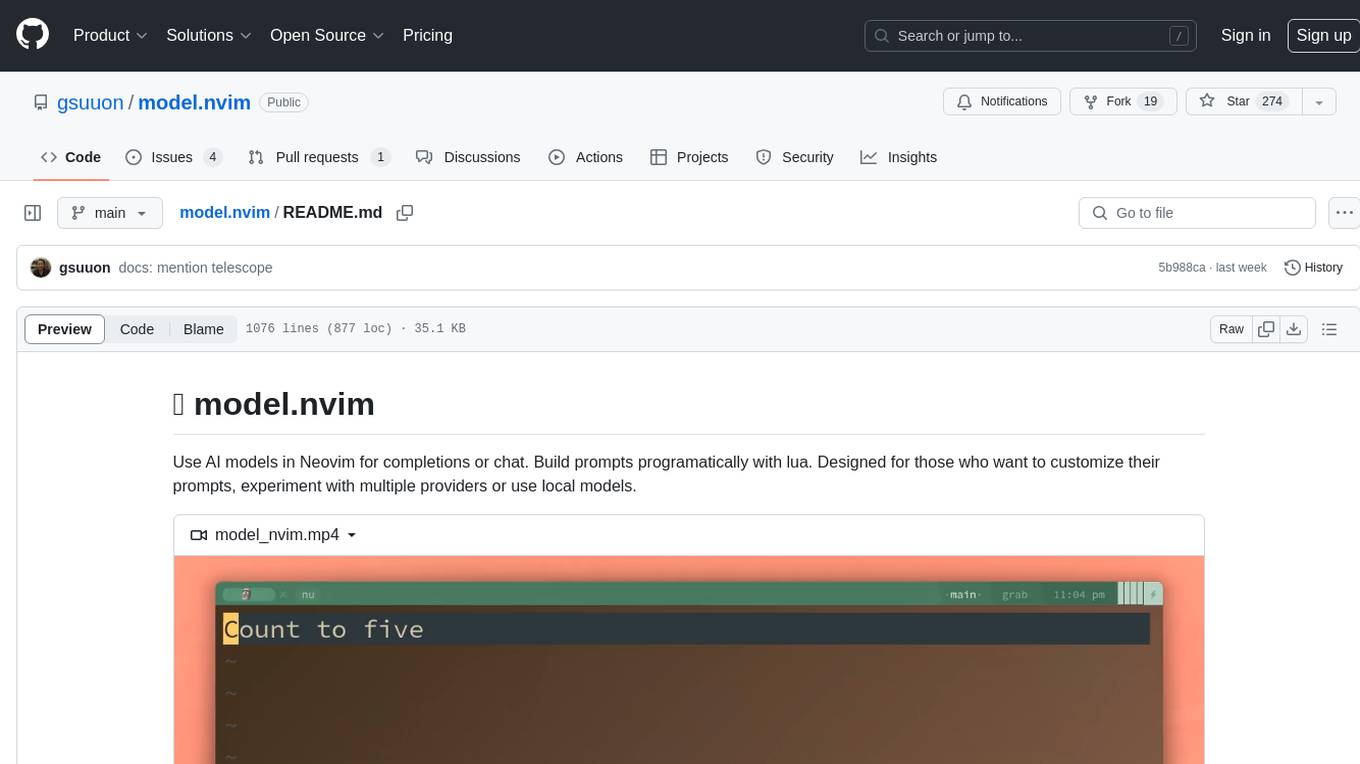
model.nvim
model.nvim is a tool designed for Neovim users who want to utilize AI models for completions or chat within their text editor. It allows users to build prompts programmatically with Lua, customize prompts, experiment with multiple providers, and use both hosted and local models. The tool supports features like provider agnosticism, programmatic prompts in Lua, async and multistep prompts, streaming completions, and chat functionality in 'mchat' filetype buffer. Users can customize prompts, manage responses, and context, and utilize various providers like OpenAI ChatGPT, Google PaLM, llama.cpp, ollama, and more. The tool also supports treesitter highlights and folds for chat buffers.
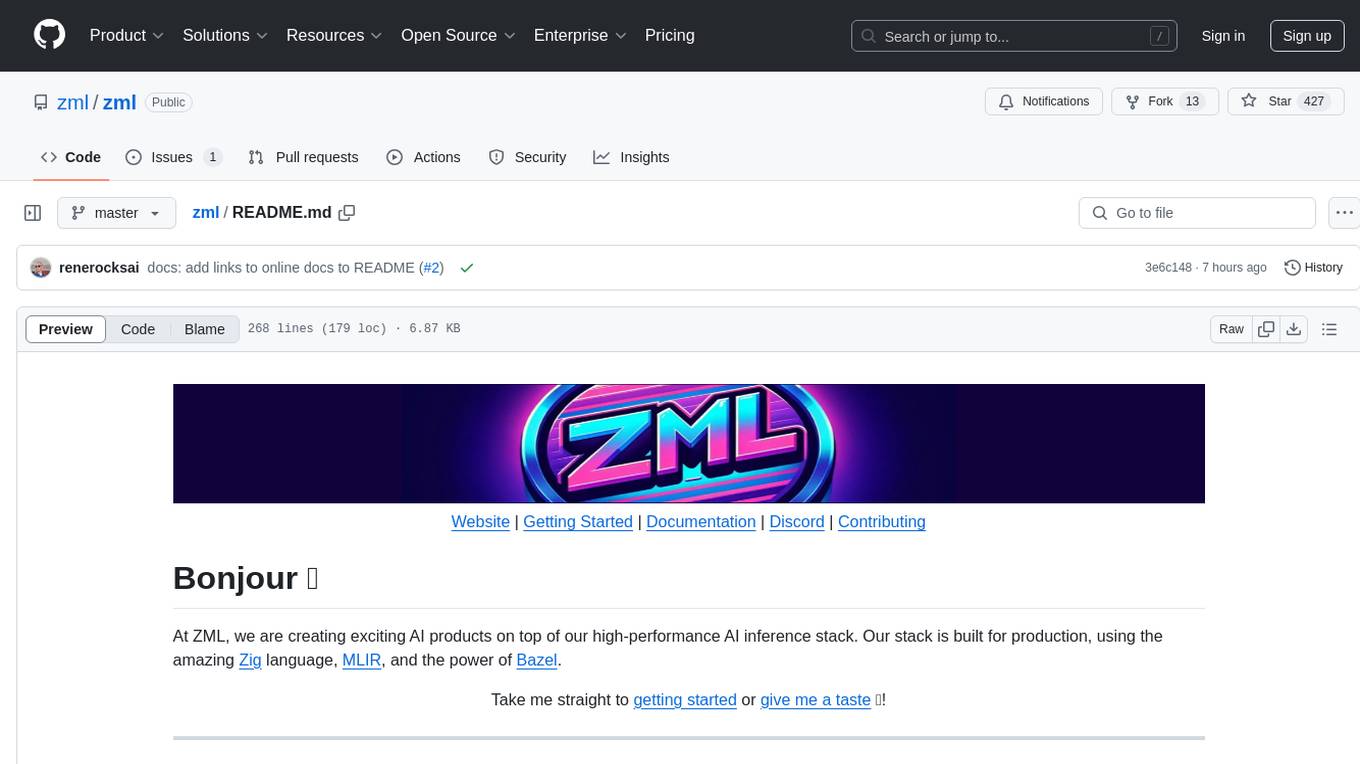
zml
ZML is a high-performance AI inference stack built for production, using Zig language, MLIR, and Bazel. It allows users to create exciting AI projects, run pre-packaged models like MNIST, TinyLlama, OpenLLama, and Meta Llama, and compile models for accelerator runtimes. Users can also run tests, explore examples, and contribute to the project. ZML is licensed under the Apache 2.0 license.
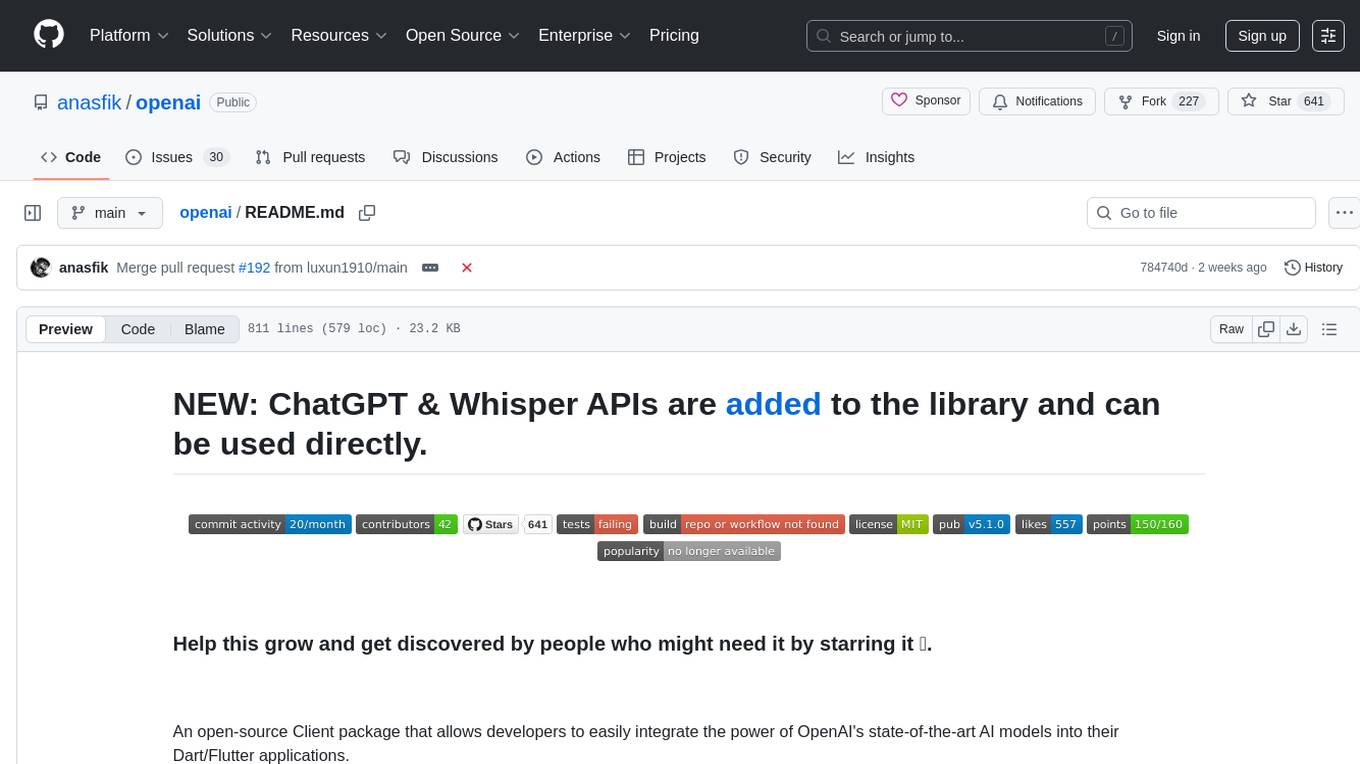
openai
An open-source client package that allows developers to easily integrate the power of OpenAI's state-of-the-art AI models into their Dart/Flutter applications. The library provides simple and intuitive methods for making requests to OpenAI's various APIs, including the GPT-3 language model, DALL-E image generation, and more. It is designed to be lightweight and easy to use, enabling developers to focus on building their applications without worrying about the complexities of dealing with HTTP requests. Note that this is an unofficial library as OpenAI does not have an official Dart library.
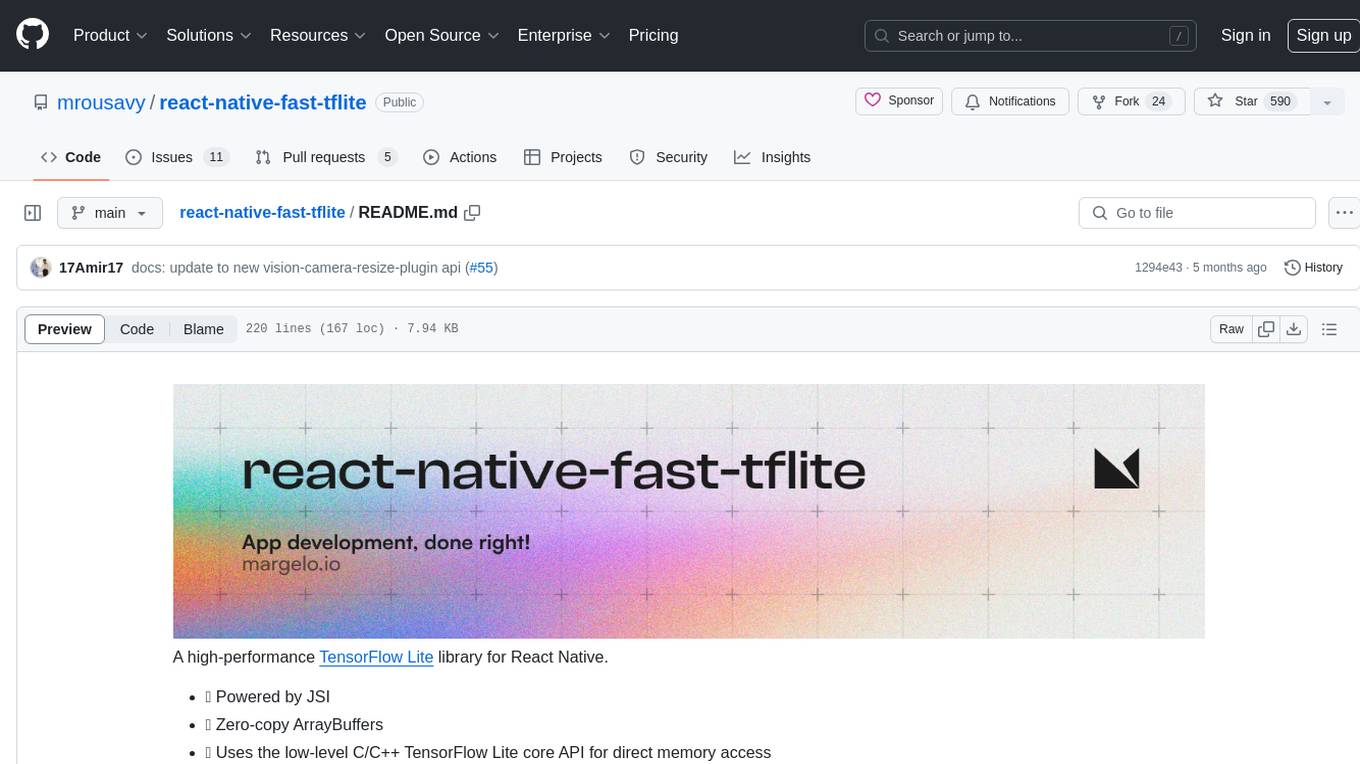
react-native-fast-tflite
A high-performance TensorFlow Lite library for React Native that utilizes JSI for power, zero-copy ArrayBuffers for efficiency, and low-level C/C++ TensorFlow Lite core API for direct memory access. It supports swapping out TensorFlow Models at runtime and GPU-accelerated delegates like CoreML/Metal/OpenGL. Easy VisionCamera integration allows for seamless usage. Users can load TensorFlow Lite models, interpret input and output data, and utilize GPU Delegates for faster computation. The library is suitable for real-time object detection, image classification, and other machine learning tasks in React Native applications.
Pixel-Reasoner
Pixel Reasoner is a framework that introduces reasoning in the pixel-space for Vision-Language Models (VLMs), enabling them to directly inspect, interrogate, and infer from visual evidences. This enhances reasoning fidelity for visual tasks by equipping VLMs with visual reasoning operations like zoom-in and select-frame. The framework addresses challenges like model's imbalanced competence and reluctance to adopt pixel-space operations through a two-phase training approach involving instruction tuning and curiosity-driven reinforcement learning. With these visual operations, VLMs can interact with complex visual inputs such as images or videos to gather necessary information, leading to improved performance across visual reasoning benchmarks.
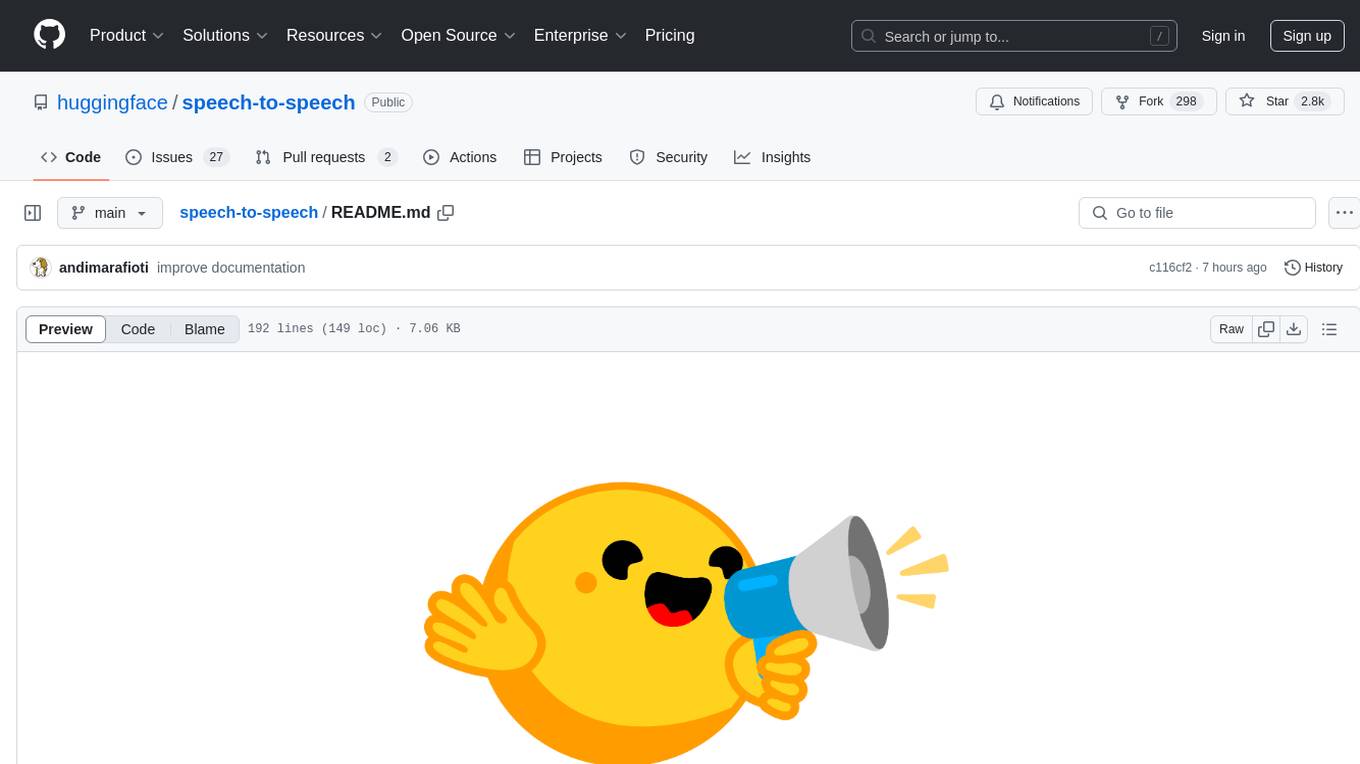
speech-to-speech
This repository implements a speech-to-speech cascaded pipeline with consecutive parts including Voice Activity Detection (VAD), Speech to Text (STT), Language Model (LM), and Text to Speech (TTS). It aims to provide a fully open and modular approach by leveraging models available on the Transformers library via the Hugging Face hub. The code is designed for easy modification, with each component implemented as a class. Users can run the pipeline either on a server/client approach or locally, with detailed setup and usage instructions provided in the readme.
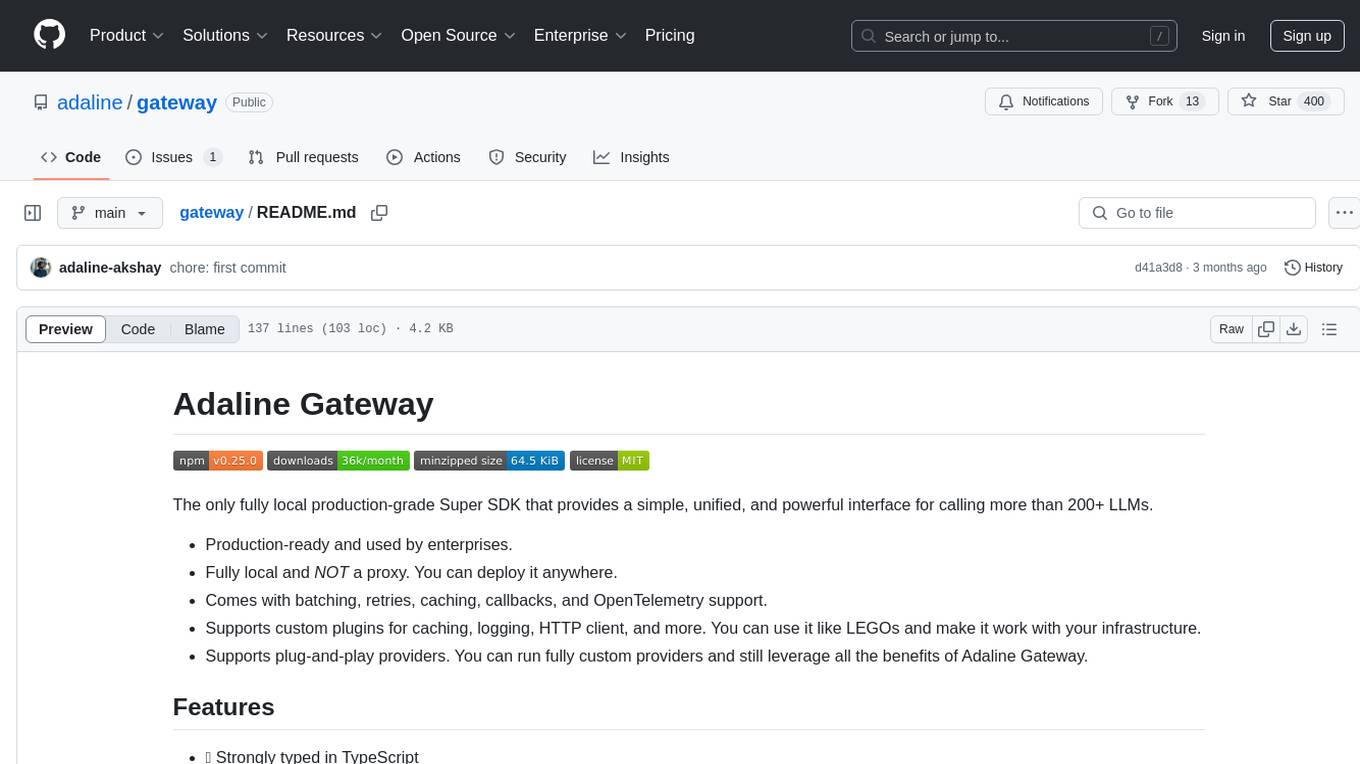
gateway
Adaline Gateway is a fully local production-grade Super SDK that offers a unified interface for calling over 200+ LLMs. It is production-ready, supports batching, retries, caching, callbacks, and OpenTelemetry. Users can create custom plugins and providers for seamless integration with their infrastructure.
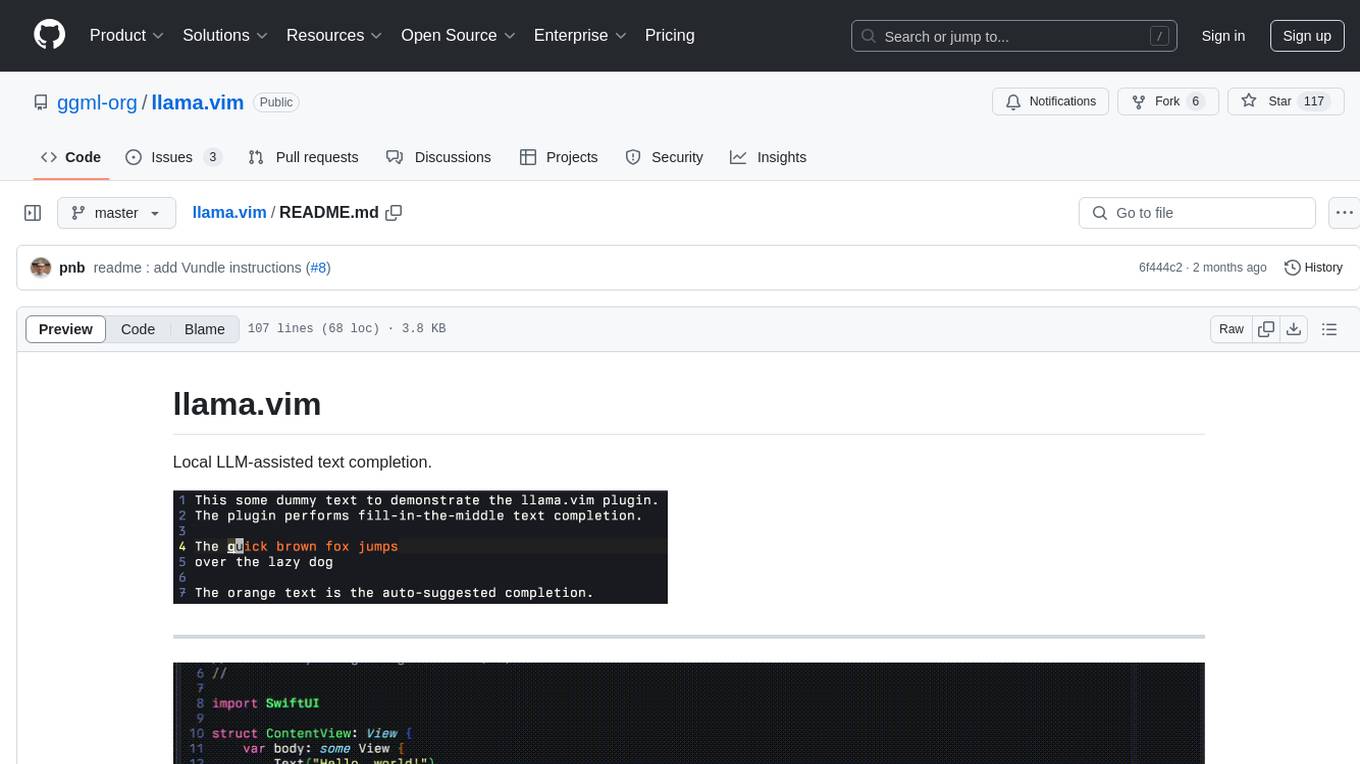
llama.vim
llama.vim is a plugin that provides local LLM-assisted text completion for Vim users. It offers features such as auto-suggest on cursor movement, manual suggestion toggling, suggestion acceptance with Tab and Shift+Tab, control over text generation time, context configuration, ring context with chunks from open and edited files, and performance stats display. The plugin requires a llama.cpp server instance to be running and supports FIM-compatible models. It aims to be simple, lightweight, and provide high-quality and performant local FIM completions even on consumer-grade hardware.
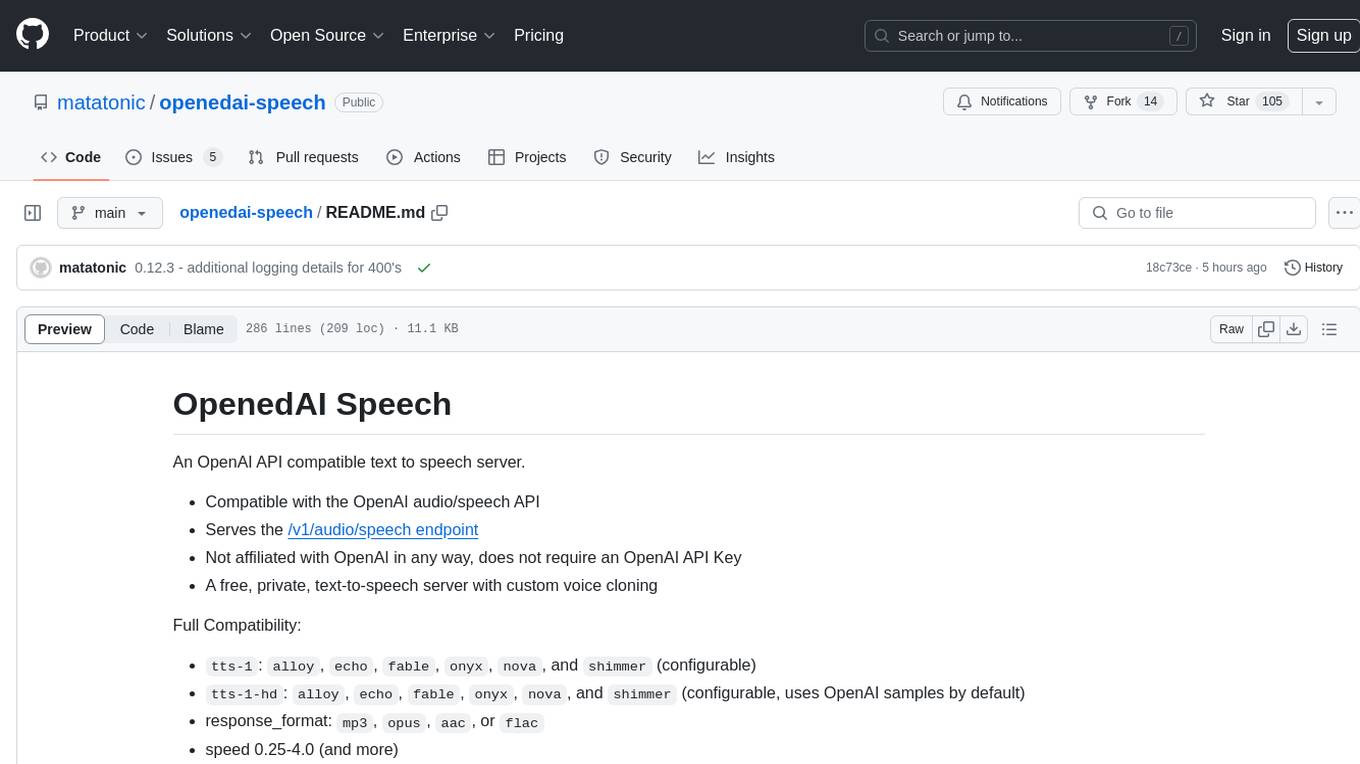
openedai-speech
OpenedAI Speech is a free, private text-to-speech server compatible with the OpenAI audio/speech API. It offers custom voice cloning and supports various models like tts-1 and tts-1-hd. Users can map their own piper voices and create custom cloned voices. The server provides multilingual support with XTTS voices and allows fixing incorrect sounds with regex. Recent changes include bug fixes, improved error handling, and updates for multilingual support. Installation can be done via Docker or manual setup, with usage instructions provided. Custom voices can be created using Piper or Coqui XTTS v2, with guidelines for preparing audio files. The tool is suitable for tasks like generating speech from text, creating custom voices, and multilingual text-to-speech applications.
For similar tasks
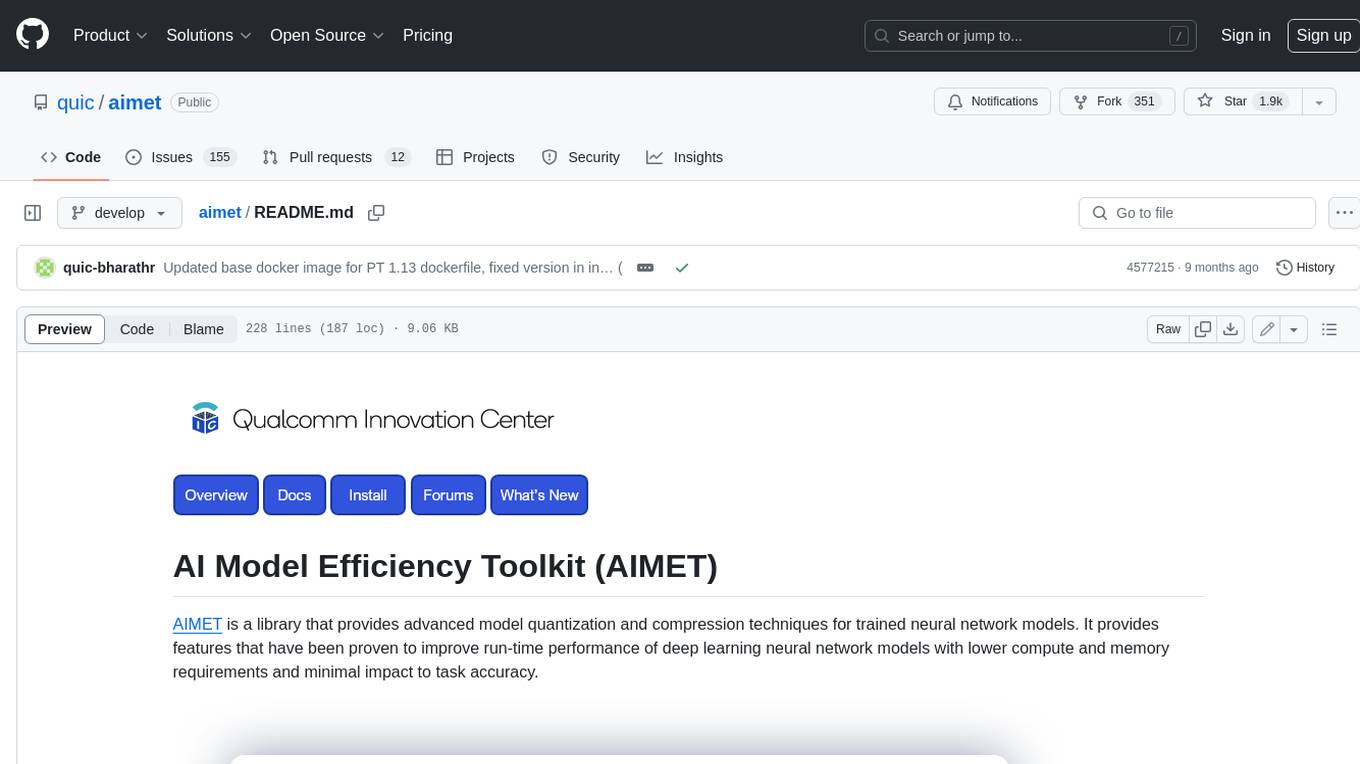
aimet
AIMET is a library that provides advanced model quantization and compression techniques for trained neural network models. It provides features that have been proven to improve run-time performance of deep learning neural network models with lower compute and memory requirements and minimal impact to task accuracy. AIMET is designed to work with PyTorch, TensorFlow and ONNX models. We also host the AIMET Model Zoo - a collection of popular neural network models optimized for 8-bit inference. We also provide recipes for users to quantize floating point models using AIMET.

hqq
HQQ is a fast and accurate model quantizer that skips the need for calibration data. It's super simple to implement (just a few lines of code for the optimizer). It can crunch through quantizing the Llama2-70B model in only 4 minutes! 🚀
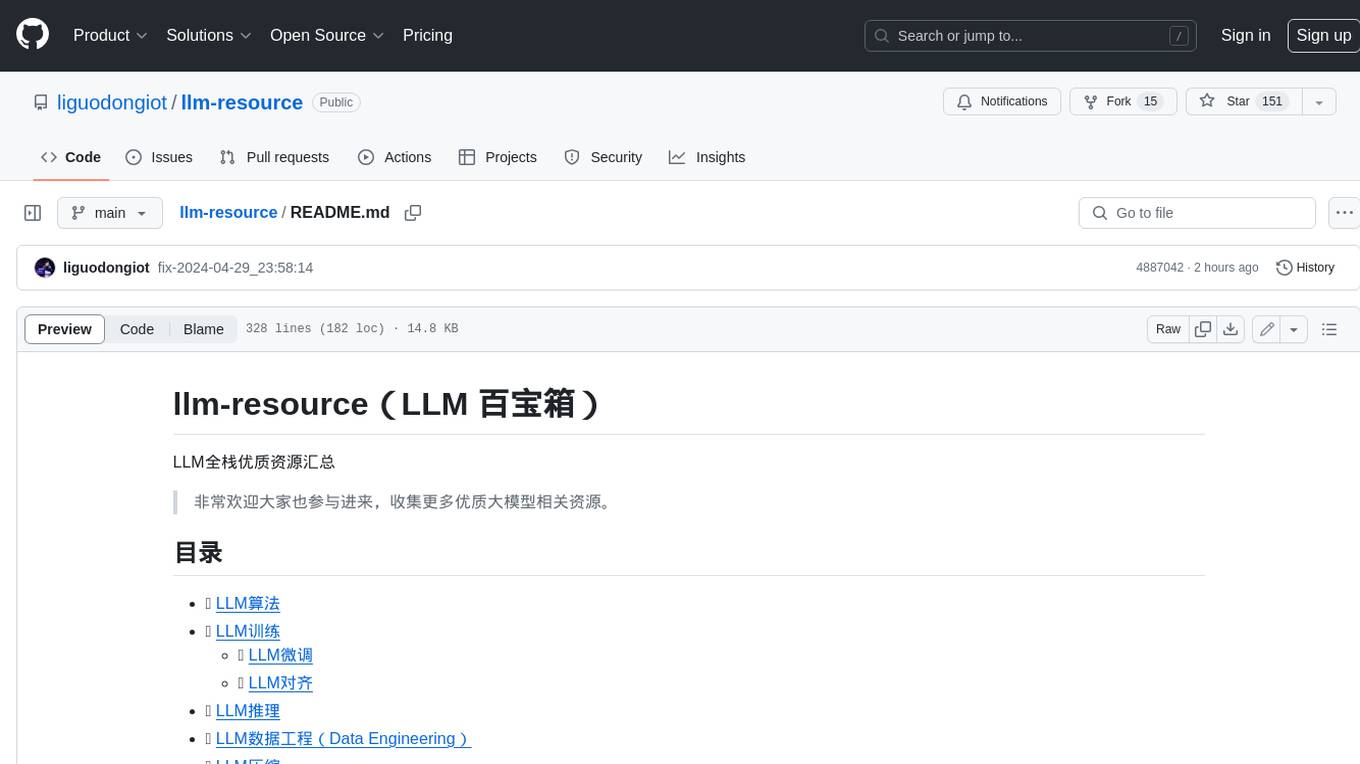
llm-resource
llm-resource is a comprehensive collection of high-quality resources for Large Language Models (LLM). It covers various aspects of LLM including algorithms, training, fine-tuning, alignment, inference, data engineering, compression, evaluation, prompt engineering, AI frameworks, AI basics, AI infrastructure, AI compilers, LLM application development, LLM operations, AI systems, and practical implementations. The repository aims to gather and share valuable resources related to LLM for the community to benefit from.
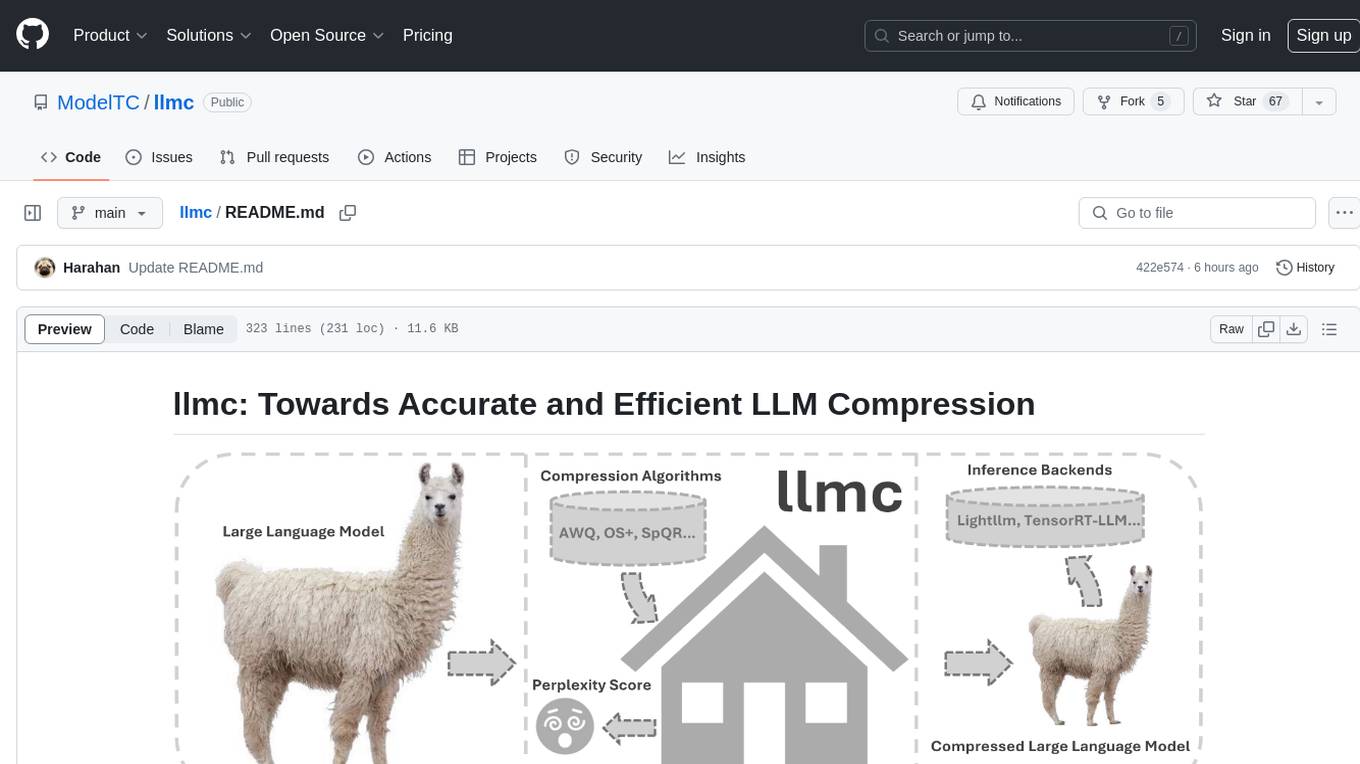
llmc
llmc is an off-the-shell tool designed for compressing LLM, leveraging state-of-the-art compression algorithms to enhance efficiency and reduce model size without compromising performance. It provides users with the ability to quantize LLMs, choose from various compression algorithms, export transformed models for further optimization, and directly infer compressed models with a shallow memory footprint. The tool supports a range of model types and quantization algorithms, with ongoing development to include pruning techniques. Users can design their configurations for quantization and evaluation, with documentation and examples planned for future updates. llmc is a valuable resource for researchers working on post-training quantization of large language models.
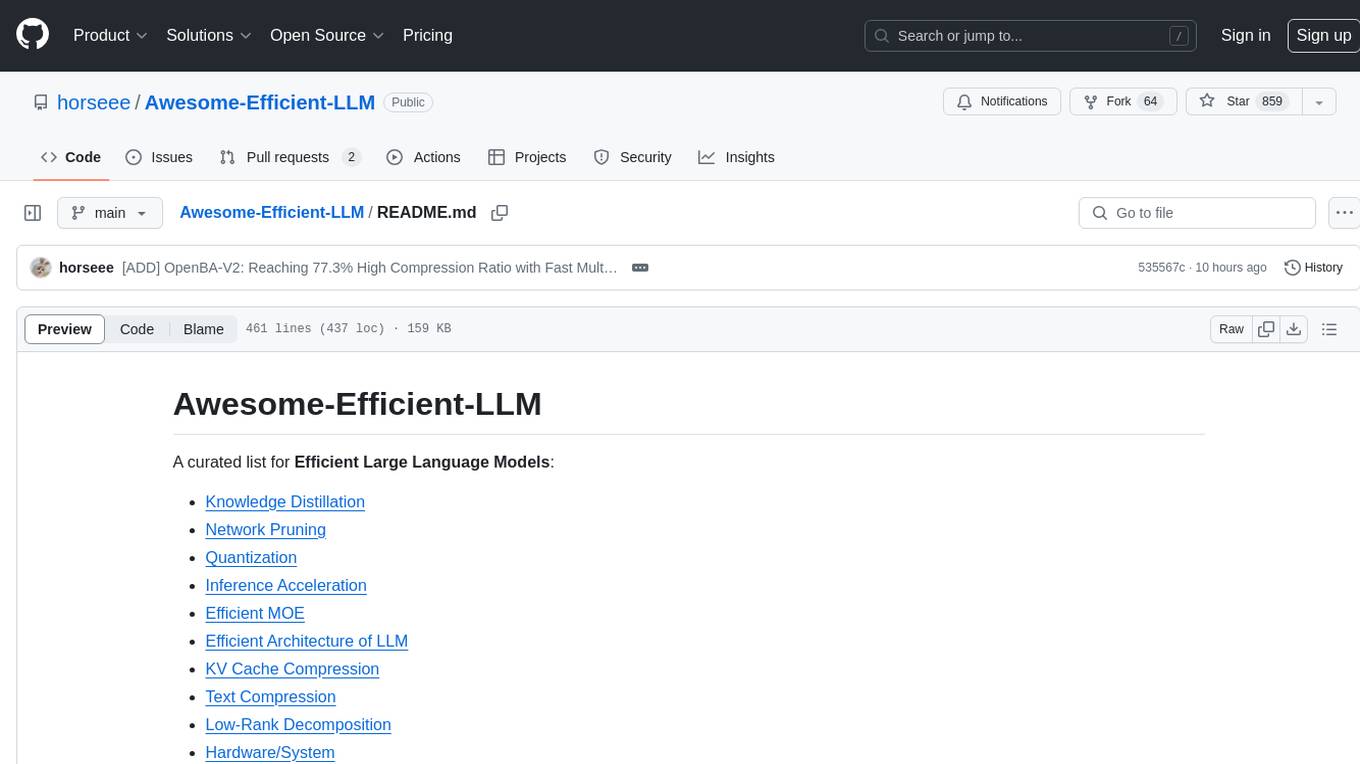
Awesome-Efficient-LLM
Awesome-Efficient-LLM is a curated list focusing on efficient large language models. It includes topics such as knowledge distillation, network pruning, quantization, inference acceleration, efficient MOE, efficient architecture of LLM, KV cache compression, text compression, low-rank decomposition, hardware/system, tuning, and survey. The repository provides a collection of papers and projects related to improving the efficiency of large language models through various techniques like sparsity, quantization, and compression.
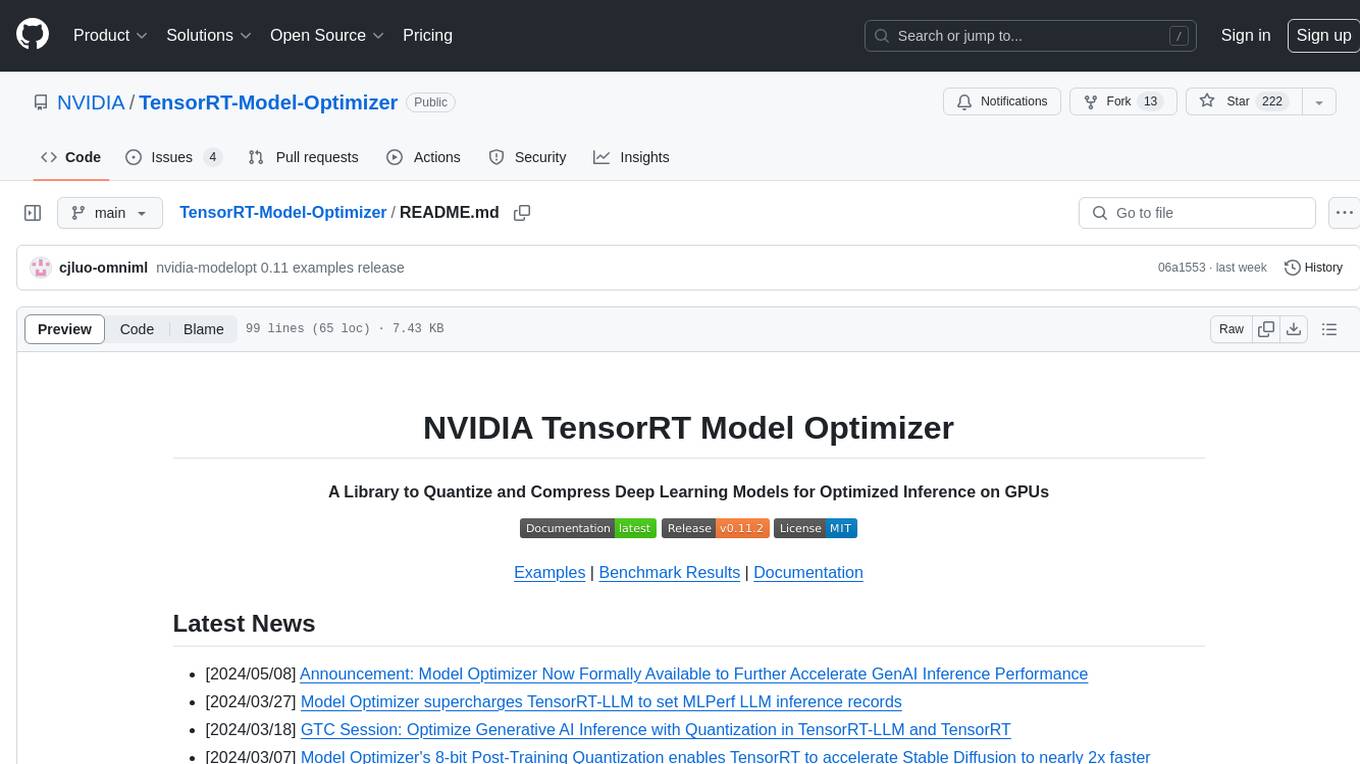
TensorRT-Model-Optimizer
The NVIDIA TensorRT Model Optimizer is a library designed to quantize and compress deep learning models for optimized inference on GPUs. It offers state-of-the-art model optimization techniques including quantization and sparsity to reduce inference costs for generative AI models. Users can easily stack different optimization techniques to produce quantized checkpoints from torch or ONNX models. The quantized checkpoints are ready for deployment in inference frameworks like TensorRT-LLM or TensorRT, with planned integrations for NVIDIA NeMo and Megatron-LM. The tool also supports 8-bit quantization with Stable Diffusion for enterprise users on NVIDIA NIM. Model Optimizer is available for free on NVIDIA PyPI, and this repository serves as a platform for sharing examples, GPU-optimized recipes, and collecting community feedback.
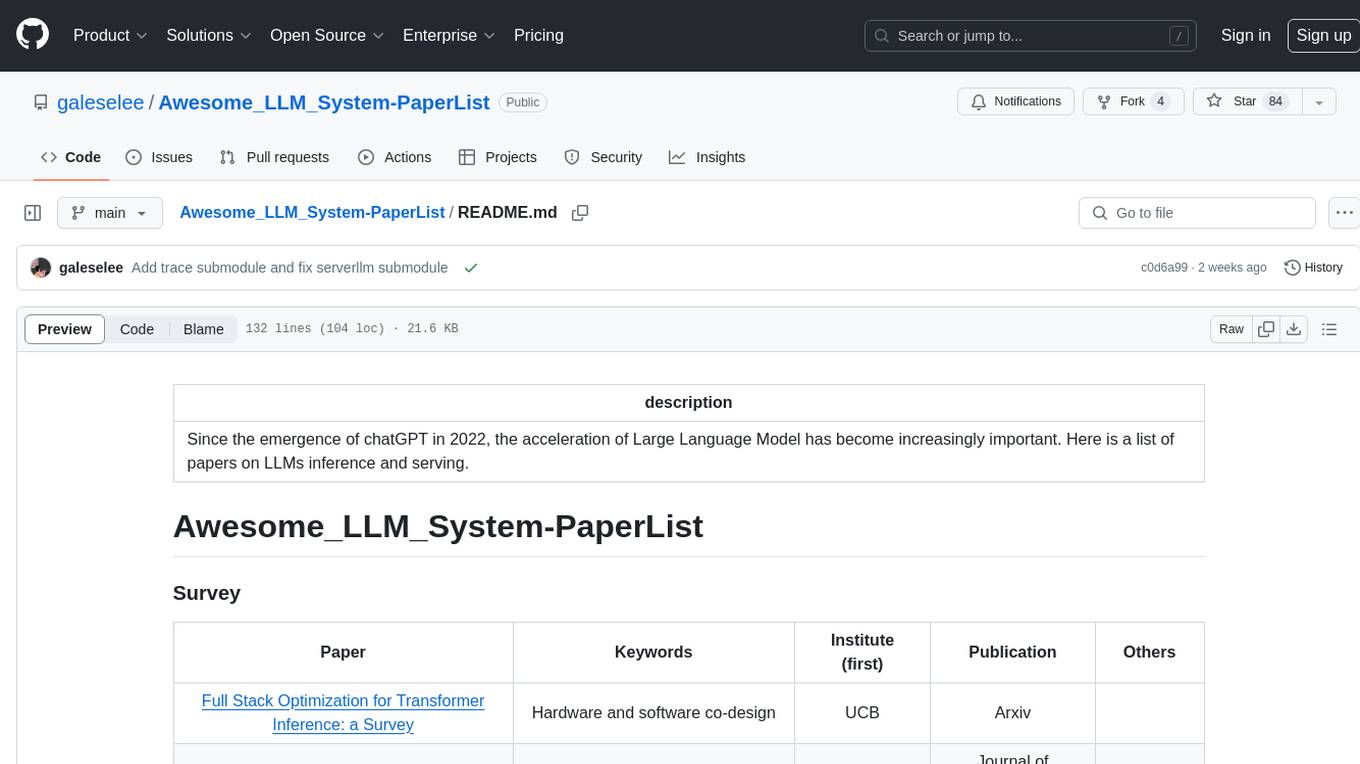
Awesome_LLM_System-PaperList
Since the emergence of chatGPT in 2022, the acceleration of Large Language Model has become increasingly important. Here is a list of papers on LLMs inference and serving.
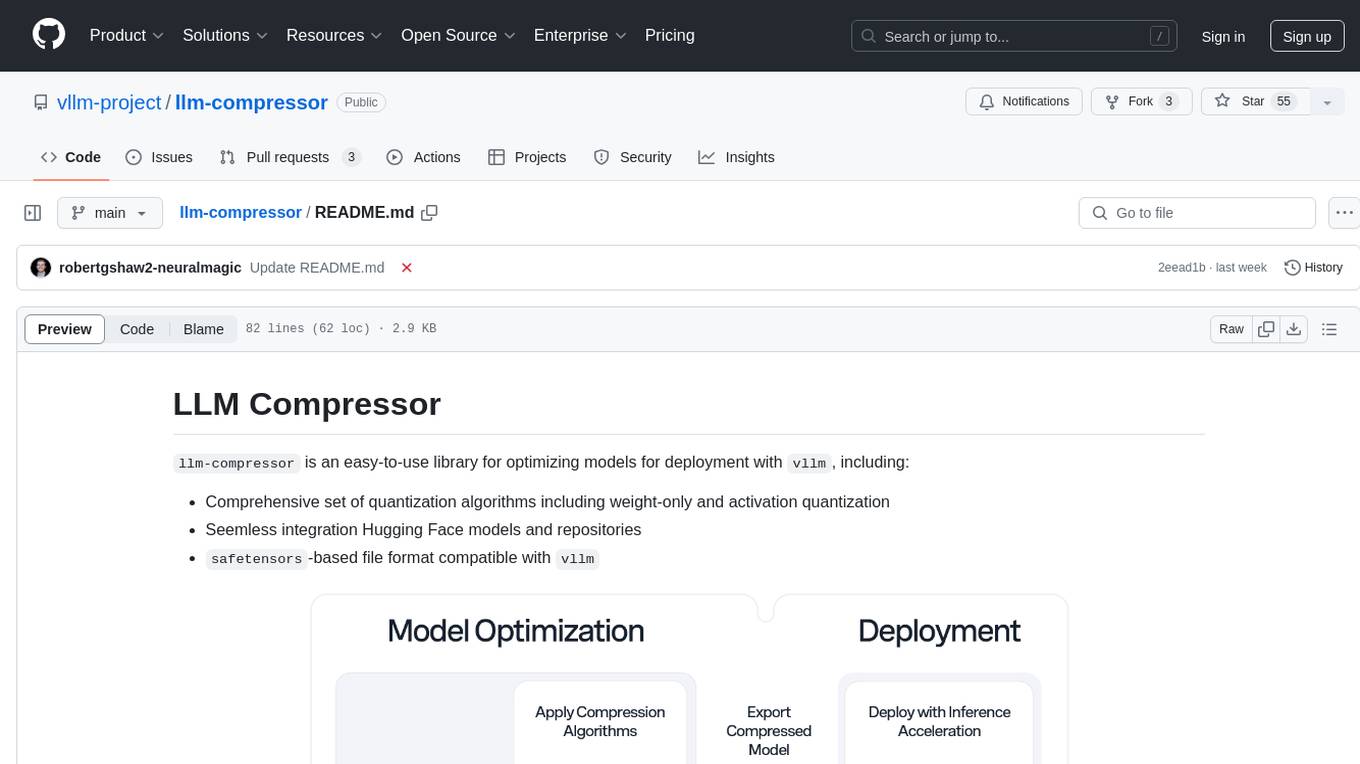
llm-compressor
llm-compressor is an easy-to-use library for optimizing models for deployment with vllm. It provides a comprehensive set of quantization algorithms, seamless integration with Hugging Face models and repositories, and supports mixed precision, activation quantization, and sparsity. Supported algorithms include PTQ, GPTQ, SmoothQuant, and SparseGPT. Installation can be done via git clone and local pip install. Compression can be easily applied by selecting an algorithm and calling the oneshot API. The library also offers end-to-end examples for model compression. Contributions to the code, examples, integrations, and documentation are appreciated.
For similar jobs

hqq
HQQ is a fast and accurate model quantizer that skips the need for calibration data. It's super simple to implement (just a few lines of code for the optimizer). It can crunch through quantizing the Llama2-70B model in only 4 minutes! 🚀
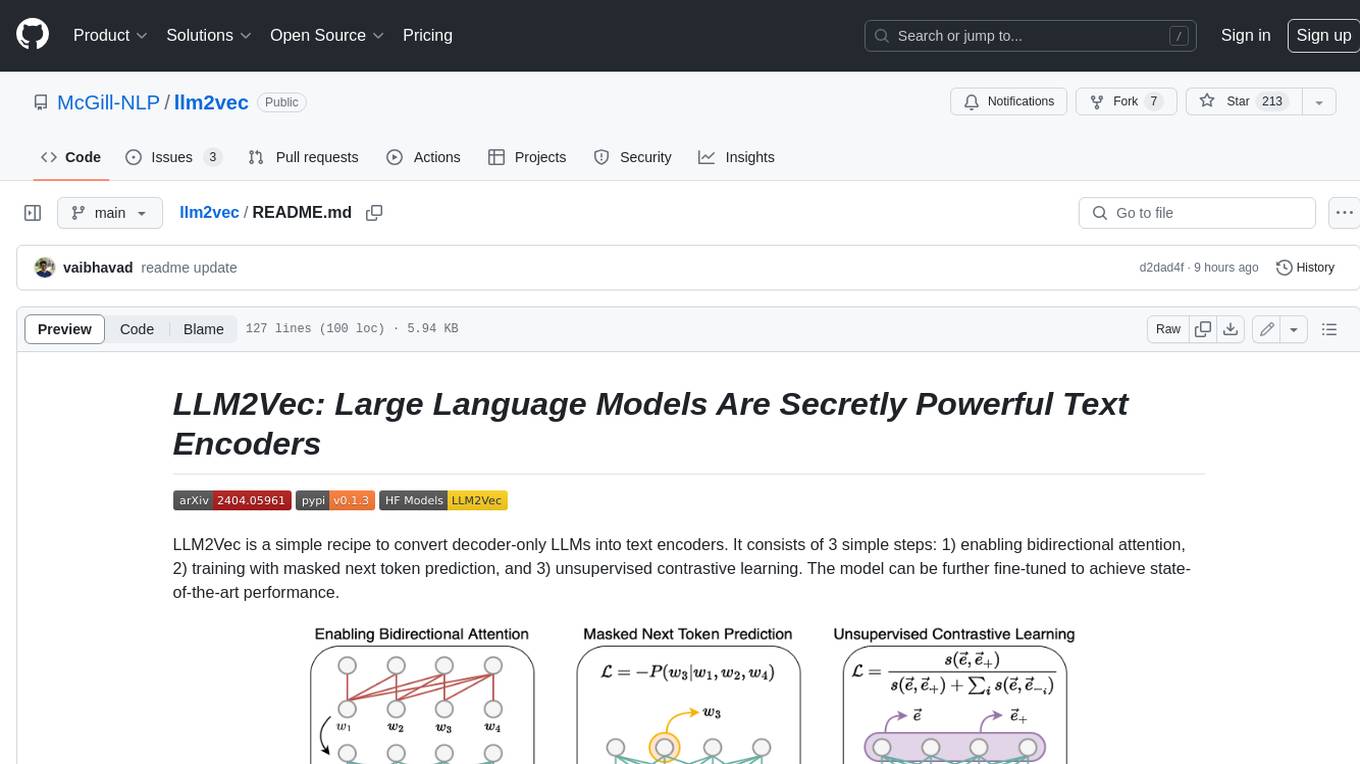
llm2vec
LLM2Vec is a simple recipe to convert decoder-only LLMs into text encoders. It consists of 3 simple steps: 1) enabling bidirectional attention, 2) training with masked next token prediction, and 3) unsupervised contrastive learning. The model can be further fine-tuned to achieve state-of-the-art performance.
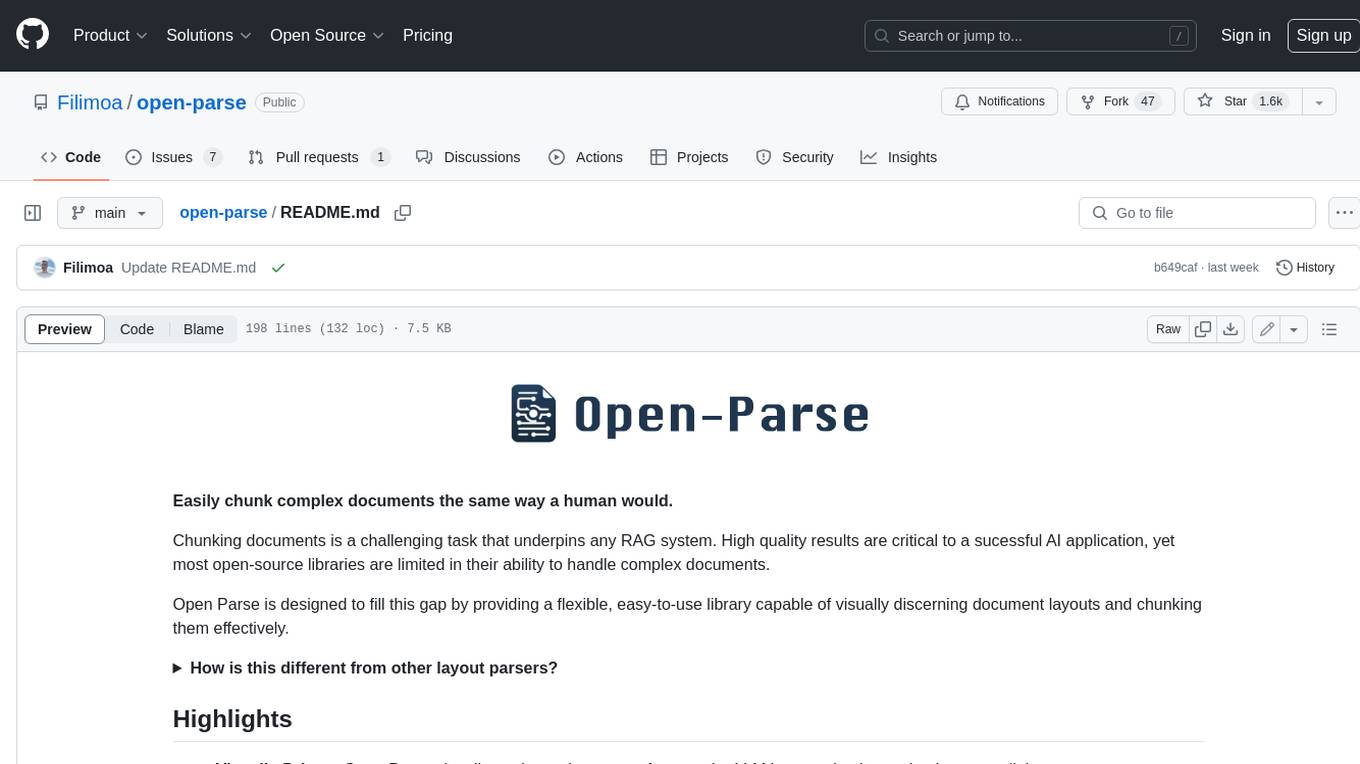
open-parse
Open Parse is a Python library for visually discerning document layouts and chunking them effectively. It is designed to fill the gap in open-source libraries for handling complex documents. Unlike text splitting, which converts a file to raw text and slices it up, Open Parse visually analyzes documents for superior LLM input. It also supports basic markdown for parsing headings, bold, and italics, and has high-precision table support, extracting tables into clean Markdown formats with accuracy that surpasses traditional tools. Open Parse is extensible, allowing users to easily implement their own post-processing steps. It is also intuitive, with great editor support and completion everywhere, making it easy to use and learn.
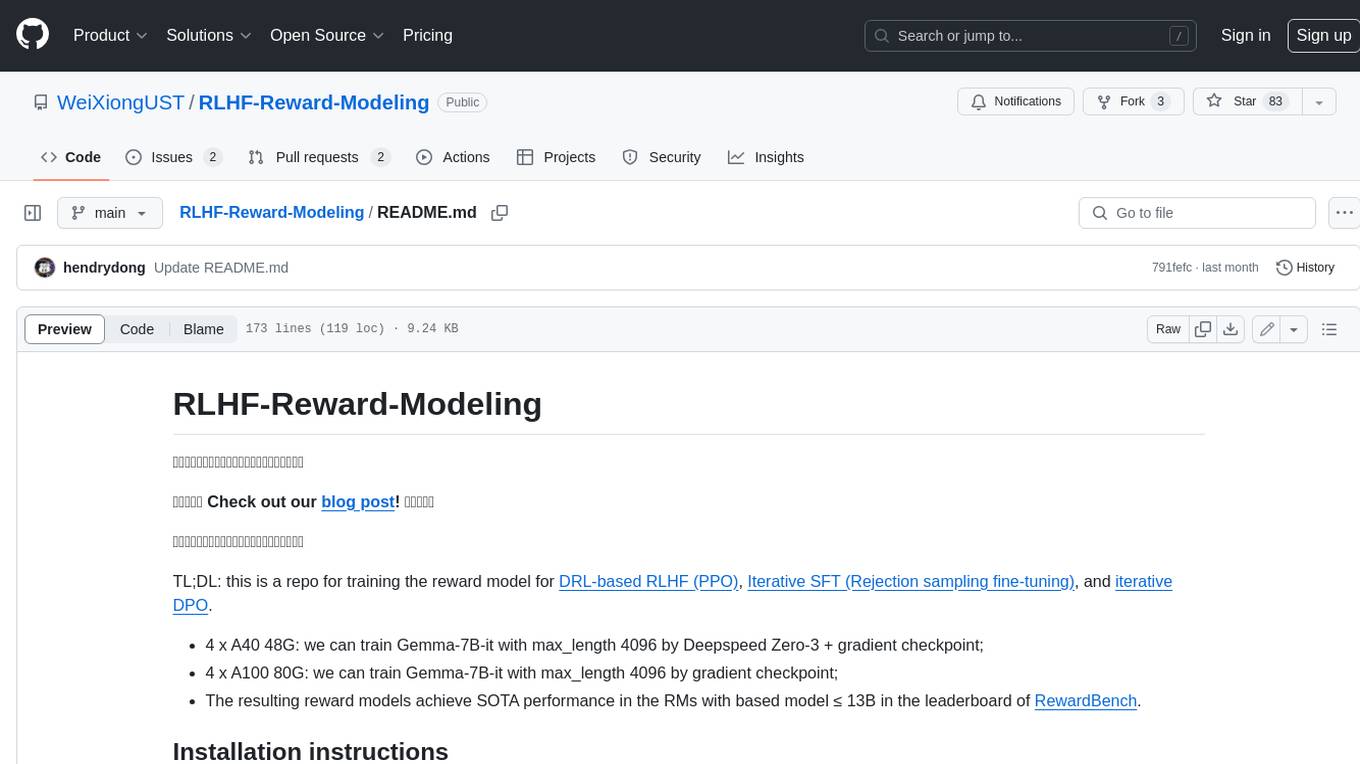
RLHF-Reward-Modeling
This repository contains code for training reward models for Deep Reinforcement Learning-based Reward-modulated Hierarchical Fine-tuning (DRL-based RLHF), Iterative Selection Fine-tuning (Rejection sampling fine-tuning), and iterative Decision Policy Optimization (DPO). The reward models are trained using a Bradley-Terry model based on the Gemma and Mistral language models. The resulting reward models achieve state-of-the-art performance on the RewardBench leaderboard for reward models with base models of up to 13B parameters.
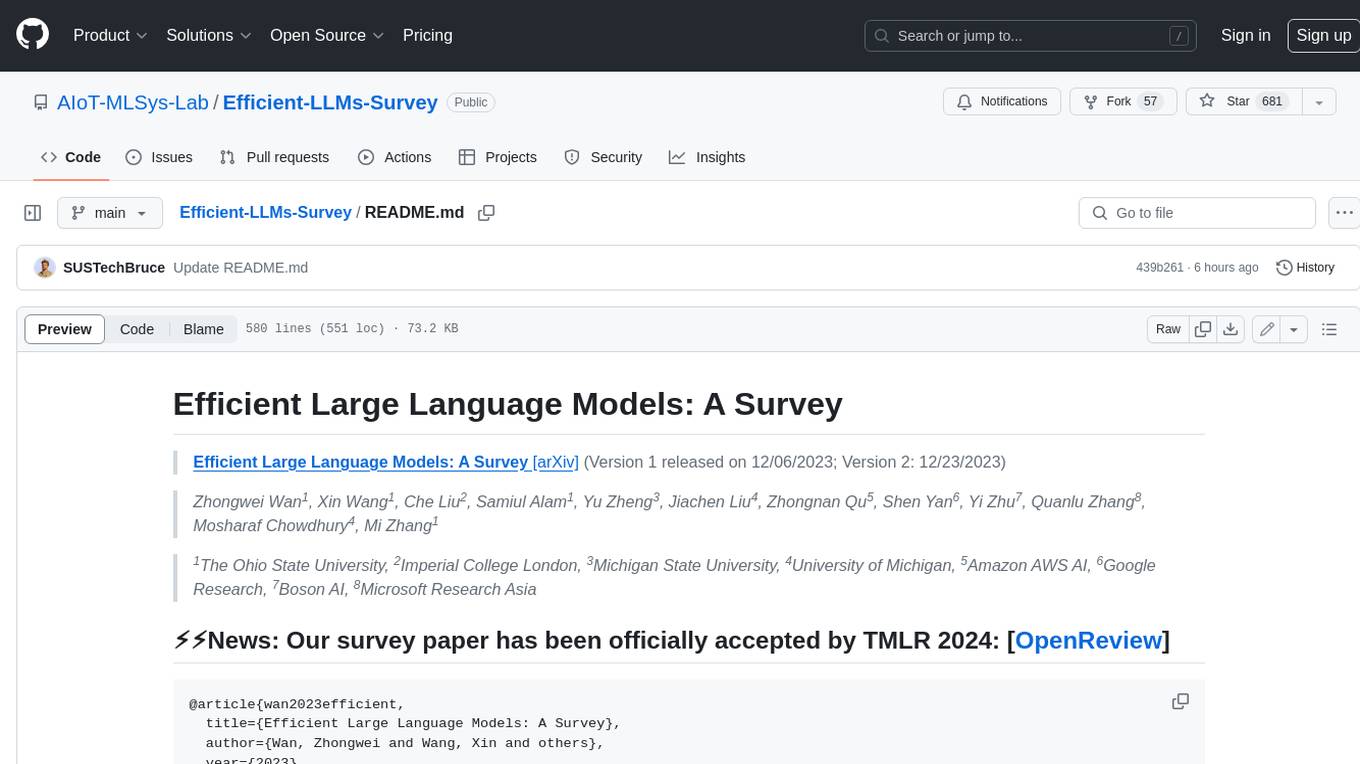
Efficient-LLMs-Survey
This repository provides a systematic and comprehensive review of efficient LLMs research. We organize the literature in a taxonomy consisting of three main categories, covering distinct yet interconnected efficient LLMs topics from **model-centric** , **data-centric** , and **framework-centric** perspective, respectively. We hope our survey and this GitHub repository can serve as valuable resources to help researchers and practitioners gain a systematic understanding of the research developments in efficient LLMs and inspire them to contribute to this important and exciting field.
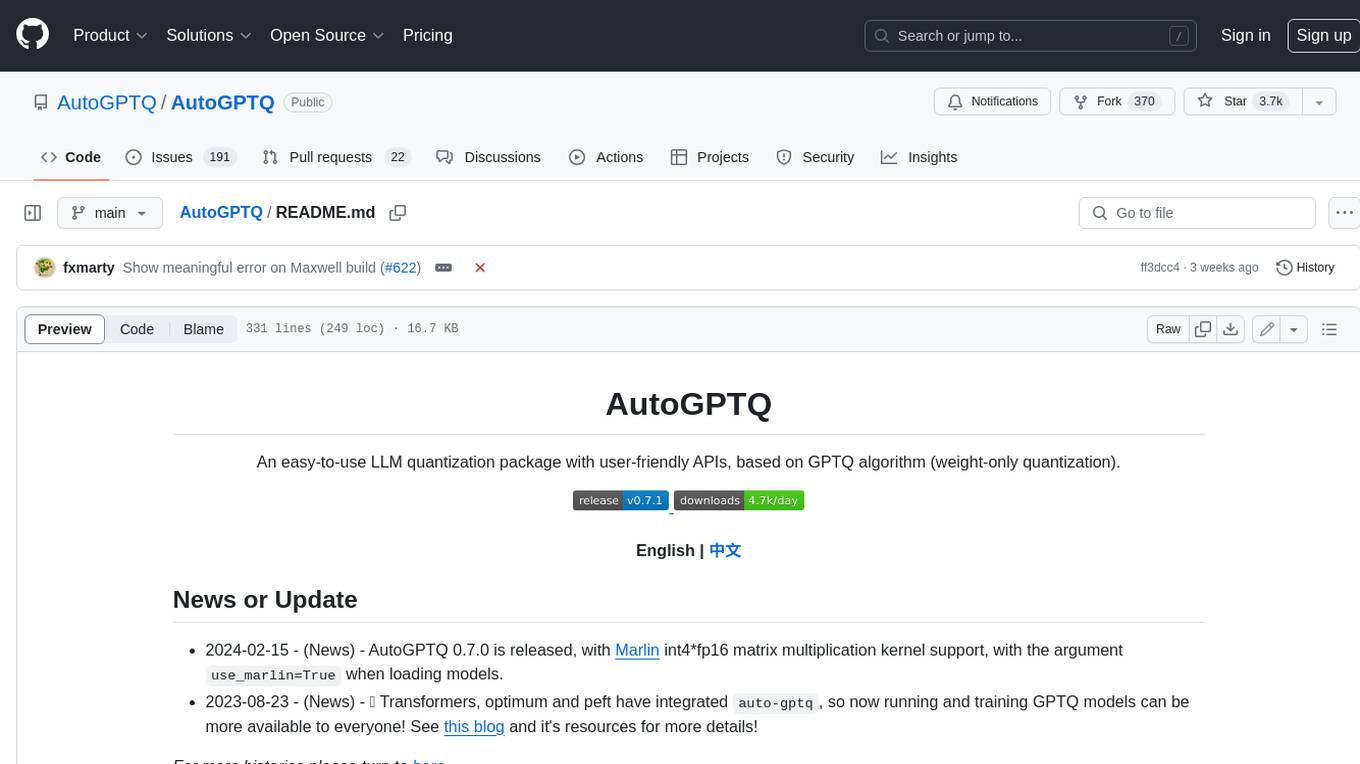
AutoGPTQ
AutoGPTQ is an easy-to-use LLM quantization package with user-friendly APIs, based on GPTQ algorithm (weight-only quantization). It provides a simple and efficient way to quantize large language models (LLMs) to reduce their size and computational cost while maintaining their performance. AutoGPTQ supports a wide range of LLM models, including GPT-2, GPT-J, OPT, and BLOOM. It also supports various evaluation tasks, such as language modeling, sequence classification, and text summarization. With AutoGPTQ, users can easily quantize their LLM models and deploy them on resource-constrained devices, such as mobile phones and embedded systems.